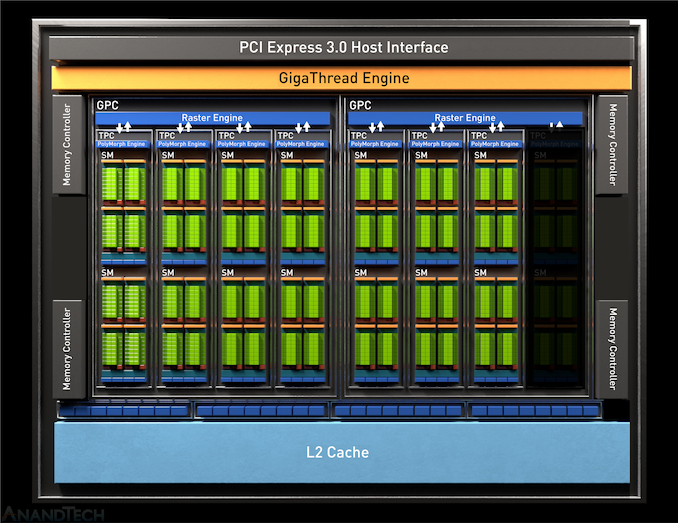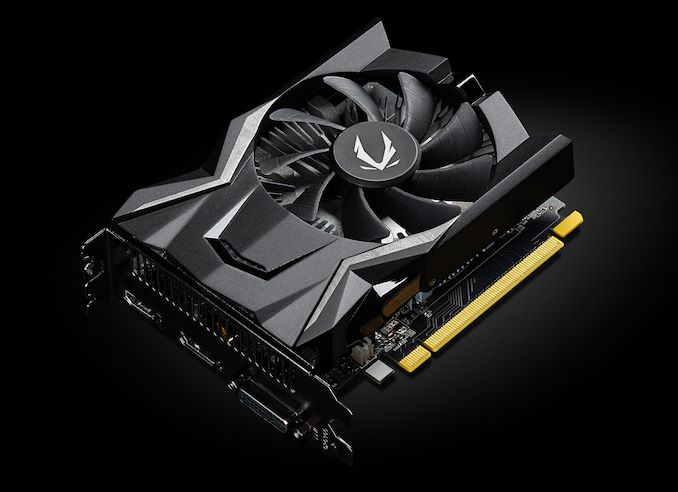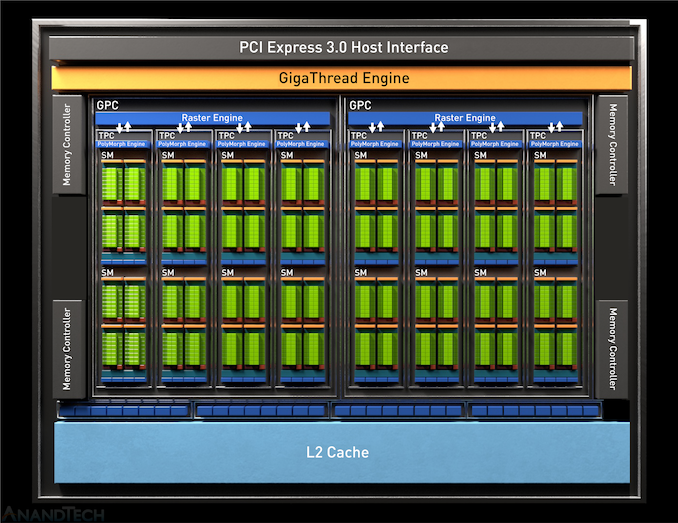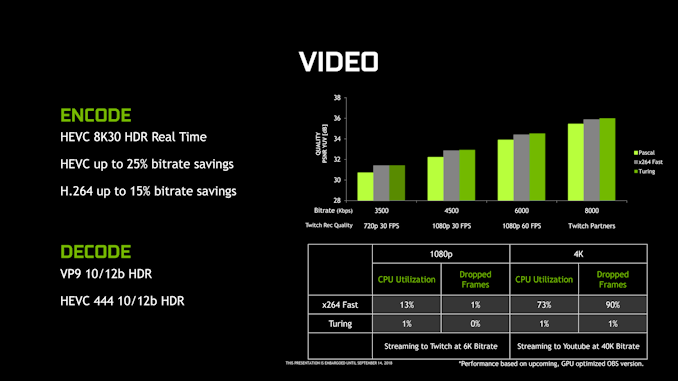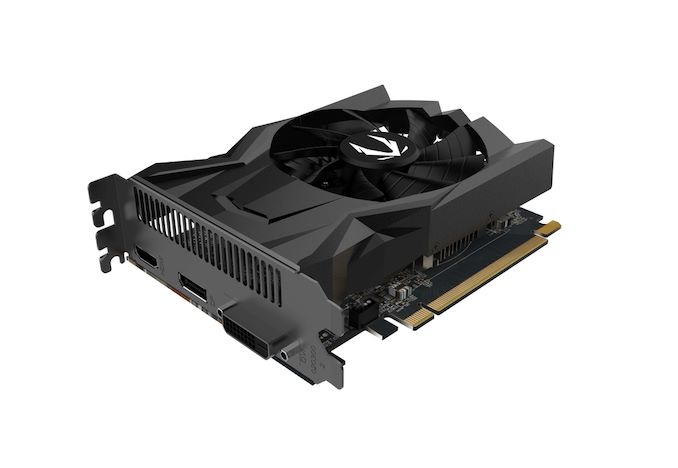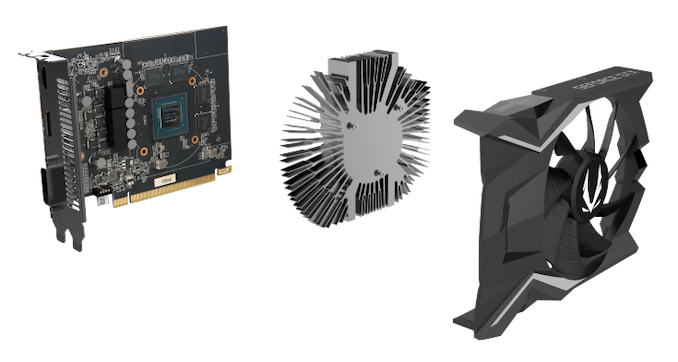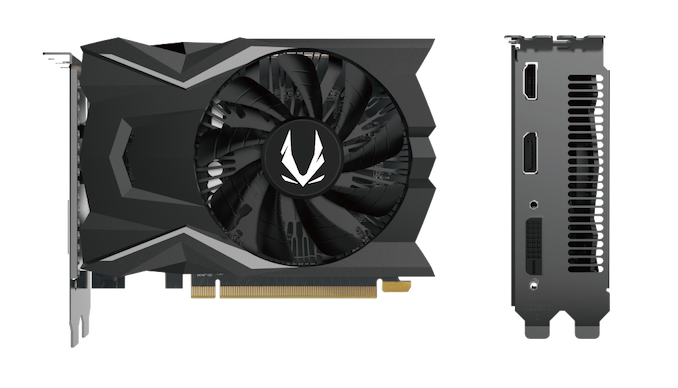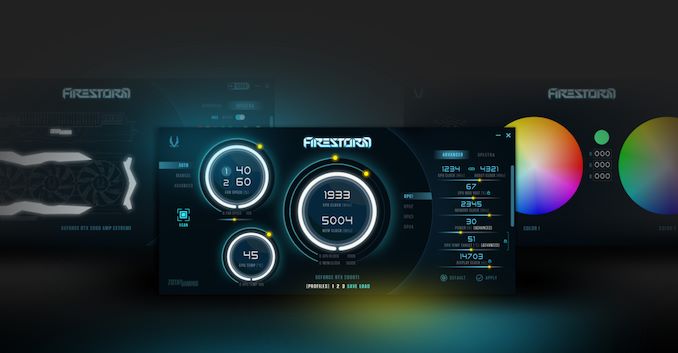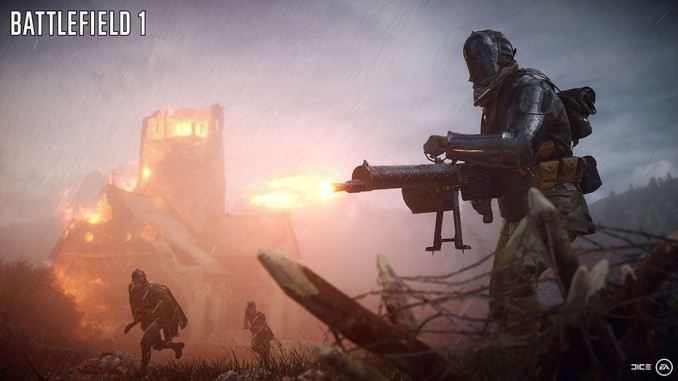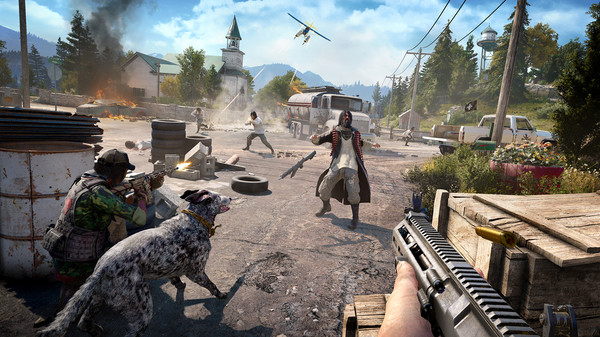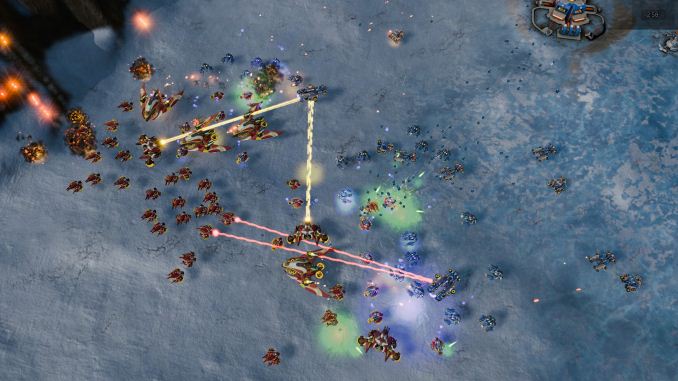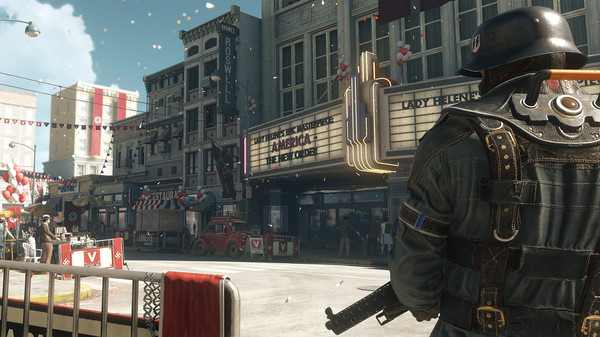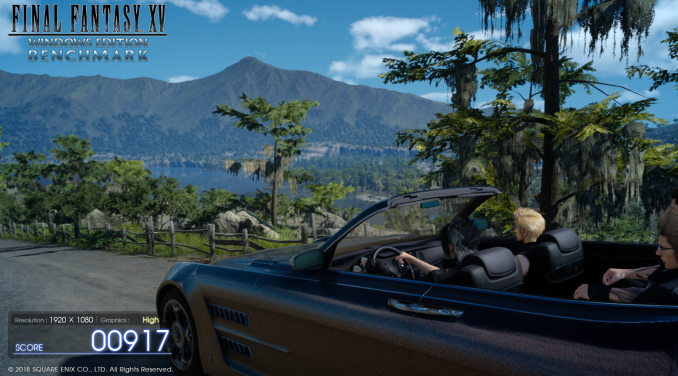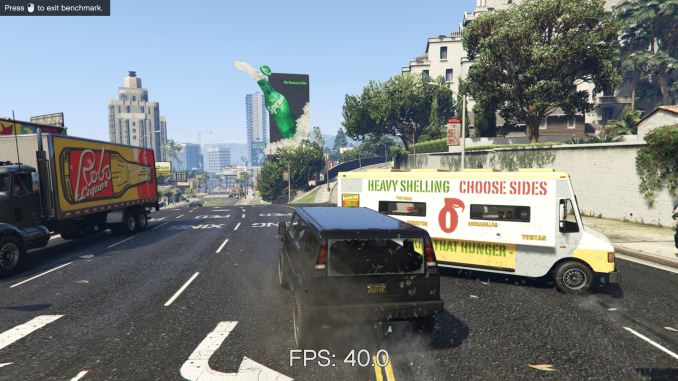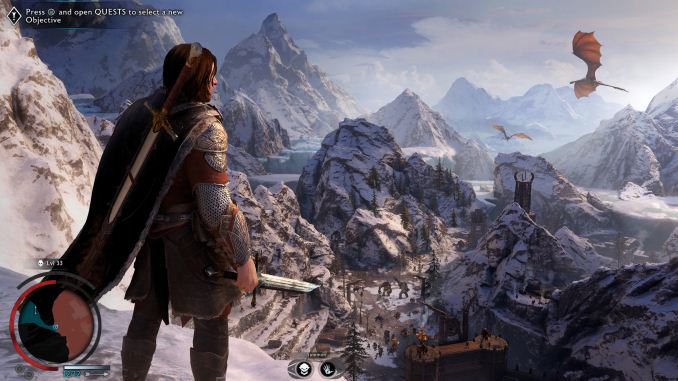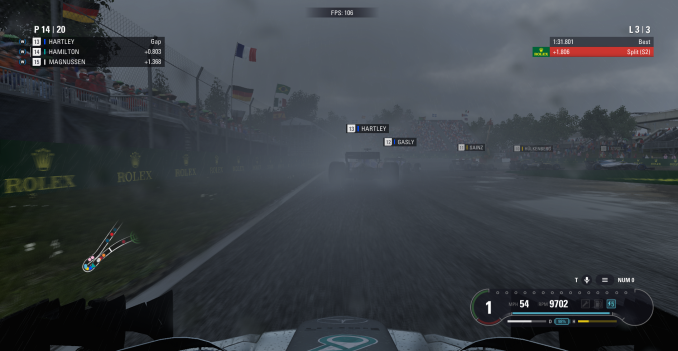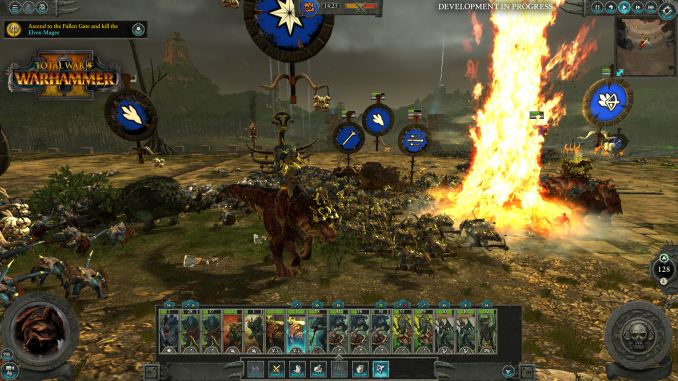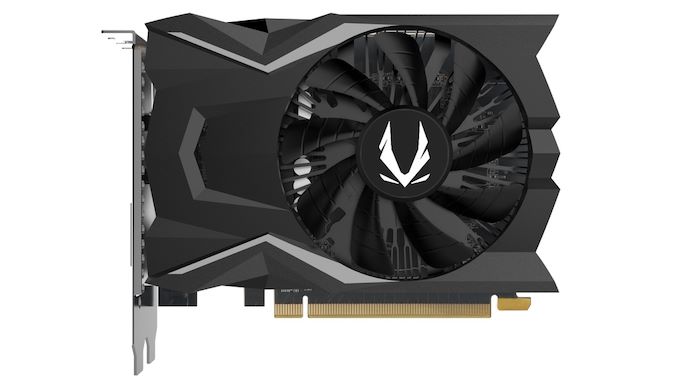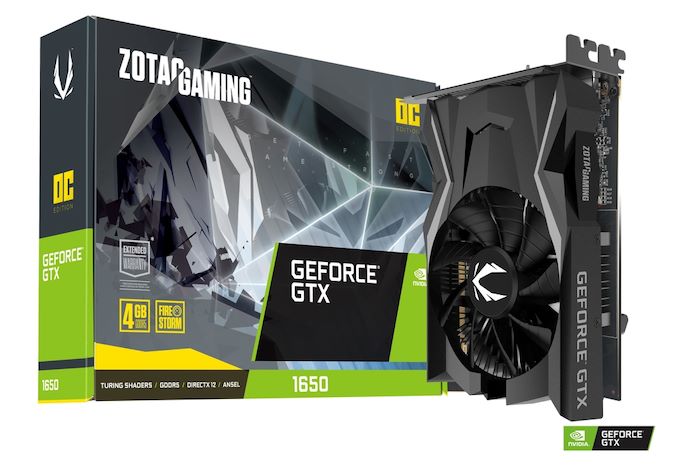
Original Link: https://www.anandtech.com/show/14270/the-nvidia-geforce-gtx-1650-review-feat-zotac
The NVIDIA GeForce GTX 1650 Review, Feat. Zotac: Fighting Brute Force With Power Efficiency
by Ryan Smith & Nate Oh on May 3, 2019 10:15 AM EST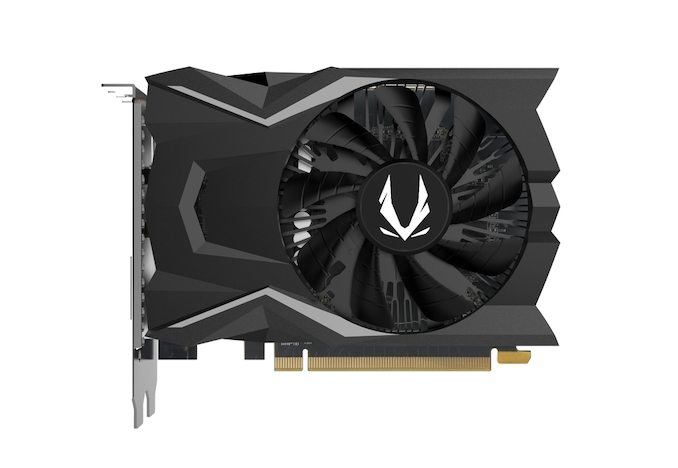
Following up on last week’s launch of NVIDIA’s new budget video card, the GeForce GTX 1650, today we’re taking a look at our first card, courtesy of Zotac. Coming in at $149, the newest member of the GeForce family brings up the rear of the GeForce product stack, offering NVIDIA’s latest architecture in a low-power, 1080p-with-compromises gaming video card with a lower price to match.
As the third member of the GeForce GTX 16 series, the GTX 1650 directly follows in the footsteps of its GTX 1660 predecessors. Built on a newer, smaller GPU specifically for these sorts of low-end cards, the underlying TU117 GPU is designed around the same leaner and meaner philosophy as TU116 before it. This means it eschews the dedicated ray tracing (RT) cores and the AI-focused tensor cores in favor of making smaller, easier to produce chips that retain the all-important core Turing architecture.
The net result of this process, the GeForce GTX 1650, is a somewhat unassuming card if we’re going by the numbers, but an important one for NVIDIA’s product stack. Though its performance is pedestrian by high-end PC gaming standards, the card fills out NVIDIA’s lineup by offering a modern Turing-powered card under $200. Meanwhile for the low-power video card market, the GTX 1650 is an important shot in the arm, offering the first performance boost for this hard-capped market in over two years. The end result is that the GTX 1650 will serve many masters, and as we’ll see, it serves some better than others.
| NVIDIA GeForce Specification Comparison | ||||||
| GTX 1650 | GTX 1660 | GTX 1050 Ti | GTX 1050 | |||
| CUDA Cores | 896 | 1408 | 768 | 640 | ||
| ROPs | 32 | 48 | 32 | 32 | ||
| Core Clock | 1485MHz | 1530MHz | 1290MHz | 1354MHz | ||
| Boost Clock | 1665MHz | 1785MHz | 1392MHz | 1455MHz | ||
| Memory Clock | 8Gbps GDDR5 | 8Gbps GDDR5 | 7Gbps GDDR5 | 7Gbps GDDR5 | ||
| Memory Bus Width | 128-bit | 192-bit | 128-bit | 128-bit | ||
| VRAM | 4GB | 6GB | 4GB | 2GB | ||
| Single Precision Perf. | 3 TFLOPS | 5 TFLOPS | 2.1 TFLOPS | 1.9 TFLOPS | ||
| TDP | 75W | 120W | 75W | 75W | ||
| GPU | TU117 (200 mm2) |
TU116 (284 mm2) |
GP107 (132 mm2) |
GP107 (132 mm2) |
||
| Transistor Count | 4.7B | 6.6B | 3.3B | 3.3B | ||
| Architecture | Turing | Turing | Pascal | Pascal | ||
| Manufacturing Process | TSMC 12nm "FFN" | TSMC 12nm "FFN" | Samsung 14nm | Samsung 14nm | ||
| Launch Date | 4/23/2019 | 3/14/2019 | 10/25/2016 | 10/25/2016 | ||
| Launch Price | $149 | $219 | $139 | $109 | ||
Right off the bat, it’s interesting to note that the GTX 1650 is not using a fully-enabled TU117 GPU. Relative to the full chip, the version that’s going into the GTX 1650 has had a TPC fused off, which means the chip loses 2 SMs/64 CUDA cores. The net result is that the GTX 1650 is a very rare case where NVIDIA doesn’t put their best foot forward right off the bat – the company is essentially sandbagging – which is a point I’ll loop back around to here in a bit.
Within NVIDIA’s historical product stack, it’s somewhat difficult to place the GTX 1650. Officially it’s the successor to the GTX 1050, which itself was a similar cut-down card. However the GTX 1050 also launched at $109, whereas the GTX 1650 launches at $149, a hefty 37% generation-over-generation price increase. Consequently, you could be excused if you thought the GTX 1650 felt a lot more like the GTX 1050 Ti’s successor, as the $149 price tag is very comparable to the GTX 1050 Ti’s $139 launch price. Either way, generation-over-generation, Turing cards have been more expensive than the Pascal cards they have replaced, and the low price of these budget cards really amplifies this difference.
Diving into the numbers then, the GTX 1650 ships with 896 CUDA cores enabled, spread over 2 GPCs. This is actually not all that big of a step up from the GeForce GTX 1050 series on paper, but Turing’s architectural changes and effective increase in graphics efficiency mean that the little card should pack a bit more of a punch than it first shows on paper. The CUDA cores themselves are clocked a bit lower than usual for a Turing card, however, with the reference-clocked GTX 1650 boosting to just 1665MHz.
Rounding out the package is 32 ROPs, which are part of the card’s 4 ROP/L2/Memory clusters. This means the card is being fed by a 128-bit memory bus, which NVIDIA has paired up with GDDR5 memory clocked at 8Gbps. Conveniently enough, this gives the card 128GB/sec of memory bandwidth, which is about 14% more than the last-generation GTX 1050 series cards got. Thankfully, while NVIDIA hasn’t done much to boost memory capacities on the other Turing cards, the same is not true for the GTX 1650: the minimum here is now 4GB, instead of the very constrained 2GB found on the GTX 1050. Not that 4GB is particularly spacious in 2019, however the card shouldn’t be quite so desperate for memory as its predecessor was.
Overall, on paper the GTX 1650 is set to deliver around 60% of the performance of the next card up in NVIDIA’s product stack, the GTX 1660. And in practice, what we'll find is a little better than that, with the new card offering around 65% of a GTX 1660's performance.
Meanwhile, let’s talk about power consumption. With a (reference) TDP of 75W, the smallest member of the Turing family is also the lowest power. 75W cards have been a staple of the low-end video card market – in NVIDIA’s case, this is most xx50 cards – as a 75W TDP means that an additional PCIe power connector is not necessary, and the card can be powered solely off of the PCIe bus.
Overall these cards satisfy a few niche roles that add up to a larger market. The most straightforward of these roles is the need for a video card for basic systems where a PCIe power cable isn’t available, as well as low-power systems where a more power-hungry card isn’t appropriate. For enthusiasts, the focus tends to turn specifically towards HTPC systems, as these sorts of low-power cards are a good physical fit for those compact systems, while also offering the latest video decoding features.
It should be noted however that while the reference TDP for the GTX 1650 is 75W, board partners have been free to design their own cards with higher TDPs. As a result, many of the partner cards on the market are running faster and hotter than NVIDIA’s reference specs in order to maximize their cards’ performance, with TDPs closer to 90W. So anyone specifically looking for a 75W card to take advantage of its low power requirements will want to pay close attention to card specifications to make sure it’s actually a 75W card, like the Zotac card we’re reviewing today.
Product Positioning & The Competition
Shifting gears to business matters, let’s talk about product positioning and hardware availability.
The GeForce GTX 1650 is a hard launch for NVIDIA, and typical for low-end NVIDIA cards, there are no reference cards or reference designs to speak of. In NVIDIA parlance this is a "pure virtual" launch, meaning that NVIDIA’s board partners have been doing their own thing with their respective product lines. These include a range of coolers and form factors, as well as the aforementioned factory overclocked cards that require an external PCIe power connector in order to meet the cards' greater energy needs.
Overall, the GTX 1650 launch has been a relatively low-key affair for NVIDIA. The Turing architecture/feature set has been covered to excess at this point, and the low-end market doesn't attract the same kind of enthusiast attention as the high-end market does, so NVIDIA has been acting accordingly. On our end we're less than thrilled with NVIDIA's decision to prevent reviewers from testing the new card until after it launched, but we're finally here with a card and results in hand.
In terms of product positioning, NVIDIA is primarily pitching the GTX 1650 as an upgrade for the GeForce GTX 950 and its same-generation AMD counterparts, and this has been the same upgrade cadence gap we’ve seen throughout the rest of the GeForce Turing family. As we'll see in our benchmark results, the GTX 1650 offers a significant performance improvement over the GTX 950, while the uplift over the price-comparable GTX 1050 Ti is similar to other Turing cards at around 30%. Meanwhile, one particular advantage that it has here over past-generation cards is that with its 4GB of VRAM, the GTX 1650 doesn't struggle nearly as much on more recent games as the 2GB GTX 950 and GTX 1050 do.
Broadly speaking the GTX xx50 series of cards are meant to be 1080p-with-compromises cards, and GTX 1650 follows this trend. The GTX 1650 can run some games at 1080p at maximum image quality – including some relatively recent games – but in more demanding games it becomes a tradeoff between image quality and 60fps framerates, something the GTX 1660 doesn't really experience.
Unusual this year for NVIDIA, the company is also sweetening the pot a bit by extending their ongoing Fortnite bundle to cover the GTX 1650. The bundle itself isn’t much to write home about – some game currency and skins for a game that’s free to begin with – but it’s an unexpected move since NVIDIA wasn’t offering this bundle on the other GTX 16 series cards when they launched.
Finally, let’s take a look at the competition. AMD of course is riding out the tail-end of the Polaris-based Radeon RX 500 series, so this is what the GTX 1650 will be up against. AMD’s most comparable card in terms of total power consumption is their Radeon RX 560, a card that is simply outclassed by the far more efficient GTX 1650. The GTX 1050 series already overshot the RX 560 here, so the GTX 1650 largely serves to pile on NVIDIA’s efficiency lead, leaving AMD out of the running for 75W cards.
But this doesn’t mean AMD should be counted out altogether. Instead of the RX 560, AMD has setup the Radeon RX 570 8GB against the GTX 1650, which makes for a very interesting battle. The RX 570 is still a very capable card, especially versus the lower performance of the GTX 1650, and its 8GB of VRAM is further icing on the cake. However I’m not entirely convinced that AMD and its partners can hold 8GB card prices to $149 or less over the long run, in which case the competition may end up shifting towards the 4GB RX 570 instead.
In any case, AMD’s position is that while they can’t match the GTX 1650 on features or power efficiency – and bear in mind that the RX 570 is rated to draw almost twice as much power here – they can match it on pricing and beat it on performance. Which as long as AMD wants to hold the line here, this is a favorable matchup for AMD on a pure price/performance basis for current-generation games. The RX 570 is a last-generation midrange card, and the Turing architecture alone can’t help the low-end GTX 1650 completely make up that performance difference.
On a final note, AMD is offering their own bundle as well as part of their 50th anniversary celebration. For the RX 570 the company and its participating board partners are offering copies of bothThe Division 2 (Gold Edition) and World War Z, giving AMD a much stronger bundle than NVIDIA’s. So between card performance and game bundles, it's clear that AMD is trying very hard to counter the new GTX 1650.
| Q2 2019 GPU Pricing Comparison | |||||
| AMD | Price | NVIDIA | |||
| $349 | GeForce RTX 2060 | ||||
| Radeon RX Vega 56 | $279 | GeForce GTX 1660 Ti | |||
| Radeon RX 590 | $219 | GeForce GTX 1660 | |||
| Radeon RX 580 (8GB) | $189 | GeForce GTX 1060 3GB (1152 cores) |
|||
| Radeon RX 570 | $149 | GeForce GTX 1650 | |||
TU117: Tiny Turing
Before we take a look at the Zotac card and our benchmark results, let’s take a moment to go over the heart of the GTX 1650: the TU117 GPU.
TU117 is for most practical purposes a smaller version of the TU116 GPU, retaining the same core Turing feature set, but with fewer resources all around. Altogether, coming from the TU116 NVIDIA has shaved off one-third of the CUDA cores, one-third of the memory channels, and one-third of the ROPs, leaving a GPU that’s smaller and easier to manufacture for this low-margin market.
Still, at 200mm2 in size and housing 4.7B transistors, TU117 is by no means a simple chip. In fact, it’s exactly the same die size as GP106 – the GPU at the heart of the GeForce GTX 1060 series – so that should give you an idea of how performance and transistor counts have (slowly) cascaded down to cheaper products over the last few years.
Overall, NVIDIA’s first outing with their new GPU is an interesting one. Looking at the specs of the GTX 1650 and how NVIDIA has opted to price the card, it’s clear that NVIDIA is holding back a bit. Normally the company launches two low-end cards at the same time – a card based on a fully-enabled GPU and a cut-down card – which they haven’t done this time. This means that NVIDiA is sitting on the option of rolling out a fully-enabled TU117 card in the future if they want to.
By the numbers, the actual CUDA core count differences between GTX 1650 and a theoretical fully-enabled GTX 1650 Ti are quite limited – to the point where I doubt a few more CUDA cores alone would be worth it – however NVIDIA also has another ace up its sleeve in the form of GDDR6 memory. If the conceptually similar GTX 1660 Ti is anything to go by, a fully-enabled TU117 card with a small bump in clockspeeds and 4GB of GDDR6 could probably pull far enough ahead of the vanilla GTX 1650 to justify a new card, perhaps at $179 or so to fill NVIDIA’s current product stack gap.
The bigger question is where performance would land, and if it would be fast enough to completely fend off the Radeon RX 570. Despite the improvements over the years, bandwidth limitations are a constant challenge for GPU designers, and NVIDIA’s low-end cards have been especially boxed in. Coming straight off of standard GDDR5, the bump to GDDR6 could very well put some pep into TU117’s step. But the price sensitivity of this market (and NVIDIA’s own margin goals) means that it may be a while until we see such a card; GDDR6 memory still fetches a price premium, and I expect that NVIDIA would like to see this come down first before rolling out a GDDR6-equipped TU117 card.
Turing’s Graphics Architecture Meets Volta’s Video Encoder
While TU117 is a pure Turing chip as far as its core graphics and compute architecture is concerned, NVIDIA’s official specification tables highlight an interesting and unexpected divergence in related features. As it turns out, TU117 has incorporated an older version of NVIDIA’s NVENC video encoder block than the other Turing cards. Rather than using the Turing block, it uses the video encoding block from Volta.
But just what does the Turing NVENC block offer that Volta’s does not? As it turns out, it’s just a single feature: HEVC B-frame support.
While it wasn’t previously called out by NVIDIA in any of their Turing documentation, the NVENC block that shipped with the other Turing cards added support for B(idirectional) Frames when doing HEVC encoding. B-frames, in a nutshell, are a type of advanced frame predication for modern video codecs. Notably, B-frames incorporate information about both the frame before them and the frame after them, allowing for greater space savings versus simpler uni-directional P-frames.

I, P, and B-Frames (Petteri Aimonen / PD)
This bidirectional nature is what make B-frames so complex, and this especially goes for video encoding. As a result, while NVIDIA has supported hardware HEVC encoding for a few generations now, it’s only with Turing that they added B-frame support for that codec. The net result is that relative to Volta (and Pascal), Turing’s NVENC block can achieve similar image quality with lower bitrates, or conversely, higher image quality at the same bitrate. This is where a lot of NVIDIA’s previously touted “25% bitrate savings” for Turing come from.
Past that, however, the Volta and Turing NVENC blocks are functionally identical. Both support the same resolutions and color depths, the same codecs, etc, so while TU117 misses out on some quality/bitrate optimizations, it isn’t completely left behind. Total encoder throughput is a bit less clear, though; NVIDIA’s overall NVENC throughput has slowly ratcheted up over the generations, in particular so that their GPUs can serve up an ever-larger number of streams when being used in datacenters.
Overall this is an odd difference to bake into a GPU when the other 4 members of the Turing family all use the newer encoder, and I did reach out to NVIDIA looking for an explanation for why they regressed on the video encoder block. The answer, as it turns out, came down to die size: NVIDIA’s engineers opted to use the older encoder to keep the size of the already decently-sized 200mm2 chip from growing even larger. Unfortunately NVIDIA isn’t saying just how much larger Turing’s NVENC block is, so it’s impossible to say just how much die space this move saved. However, that the difference is apparently enough to materially impact the die size of TU117 makes me suspect it’s bigger than we normally give it credit for.
In any case, the impact to GTX 1650 will depend on the use case. HTPC users should be fine as this is solely about encoding and not decoding, so the GTX 1650 is as good for that as any other Turing card. And even in the case of game streaming/broadcasting, this is (still) mostly H.264 for compatibility and licensing reasons. But if you fall into a niche area where you’re doing GPU-accelerated HEVC encoding on a consumer card, then this is a notable difference that may make the GTX 1650 less appealing than the TU116-powered GTX 1660.
Meet The ZOTAC GAMING GeForce GTX 1650 OC
In what's becoming a theme of the GTX 16-series, the GeForce GTX 1650 is once again a pure virtual launch, where NVIDIA is not going for any Founders Edition models and all cards are up to their add-in board partners. For today's review, we take a look at ZOTAC's GeForce GTX 1650 OC, a diminutive 2-slot single-fan card with reference base clockspeed and mildly overclocked boost clock. With a TDP of 75W, the card pulls all its power from the slot, with is typical for most GeForce GTX xx50 parts.
| GeForce GTX 1650 Card Comparison | ||||
| GTX 1650 (Reference Specification) |
ZOTAC GTX 1650 GAMING OC | |||
| Base Clock | 1485MHz | 1485MHz | ||
| Boost Clock | 1665MHz | 1695MHz | ||
| Memory Clock | 8Gbps GDDR5 | 8Gbps GDDR5 | ||
| VRAM | 4GB | 4GB | ||
| TDP | 75W | 75W | ||
| Length | N/A | 5.94" | ||
| Width | N/A | 2-Slot | ||
| Cooler Type | N/A | Open Air | ||
| Price | $149 | $149 | ||
At just under 6", the Zotac GTX 1650 OC is compact enough most builds. As the card pulls power only from the PCIe slot, it's a conventional fit for mITX and other SFF builds, or simply as a no-fuss drop-in replacement. In turn, the Zotac GTX 1650 OC's cooling solution is one they've used before with their other mini ITX cards, combining a 90mm fan and 'sunflower' heatsink. This also provides headroom for ZOTAC to put a modest boost increase of 30MHz.
The design/shroud and output situation is likewise similar. One DVI port, one HDMI 2.0b port, and one DisplayPort covers all bases, including potential HTPC use. Of course, partners can always decide on different configurations but the power/cost-sensitive entry-level range is essentially standardized. VirtualLink is naturally not included here for several reasons, and in perspective the 30W USB-C controller power budget for VirtualLink would be 40% of the overall 75W TDP.
For overclocking and tweaking, ZOTAC has their in-house Firestorm utility updated for Turing, including support for auto-OC scanning as part of Turing's GPU Boost 4 technology.
The Test
While the GeForce GTX 1650 is rolling out as a fully custom launch, the nature of the entry-level segment means that boards will be very similar across the board. For one, going beyond 75W TDP would require an external PCIe power connector. So the 75W ZOTAC GeForce GTX 1650 with boost clocks dialed 30MHz down to reference is a good approximation for a generic reference GTX 1650, allowing us to keep testing and analysis as apples-to-apples as possible. While not perfect, this should be reasonably accurate for a virtual reference card as we look at reference-to-reference comparisons.
Overall, as this primarily covers cards in the low- to mid-range, all game benchmarking is done at 1080p, looking at performance on our standard 1080p Ultra settings, as well as high and medium options that are better suited for these sorts of sub-$150 cards.
| Test Setup | |||||
| CPU | Intel Core i7-7820X @ 4.3GHz | ||||
| Motherboard | Gigabyte X299 AORUS Gaming 7 (F9g) | ||||
| PSU | Corsair AX860i | ||||
| Storage | OCZ Toshiba RD400 (1TB) | ||||
| Memory | G.Skill TridentZ DDR4-3200 4 x 8GB (16-18-18-38) |
||||
| Case | NZXT Phantom 630 Windowed Edition | ||||
| Monitor | LG 27UD68P-B | ||||
| Video Cards | ZOTAC GAMING GeForce GTX 1650 OC NVIDIA GeForce GTX 1650 (4GB) AMD Radeon RX 570 8GB AMD Radeon RX 570 4GB AMD Radeon RX 460 4GB (14 CU) AMD Radeon RX 370 (2 GB) NVIDIA GeForce GTX 1660 Ti NVIDIA GeForce GTX 1660 NVIDIA GeForce GTX 1060 6GB Founders Edition (1260 cores) NVIDIA GeForce GTX 1060 3GB (1152 cores) NVIDIA GeForce GTX 1050 Ti (4GB) NVIDIA GeForce GTX 1050 2GB NVIDIA GeForce GTX 960 (2GB) NVIDIA GeForce GTX 950 NVIDIA GeForce GTX 750 Ti |
||||
| Video Drivers | NVIDIA Release 430.39 AMD Radeon Software Adrenalin 2019 Edition 19.4.3 |
||||
| OS | Windows 10 x64 Pro (1803) Spectre and Meltdown Patched |
||||
Driver-wise, in addition to not being made available before launch, the 430.39 release was not the smoothest either, with a 430.59 hotfix coming out just this week to resolve bugs and performance issues. In our testing, we did observe some flickering in Ashes.
Battlefield 1 (DX11)
Battlefield 1 returns from the 2017 benchmark suite, the 2017 benchmark suite with a bang as DICE brought gamers the long-awaited AAA World War 1 shooter a little over a year ago. With detailed maps, environmental effects, and pacy combat, Battlefield 1 provides a generally well-optimized yet demanding graphics workload. The next Battlefield game from DICE, Battlefield V, completes the nostalgia circuit with a return to World War 2, but more importantly for us, is one of the flagship titles for GeForce RTX real time ray tracing.
We use the Ultra, High, and Medium presets is used with no alterations. As these benchmarks are from single player mode, our rule of thumb with multiplayer performance still applies: multiplayer framerates generally dip to half our single player framerates. Battlefield 1 also supports HDR (HDR10, Dolby Vision).
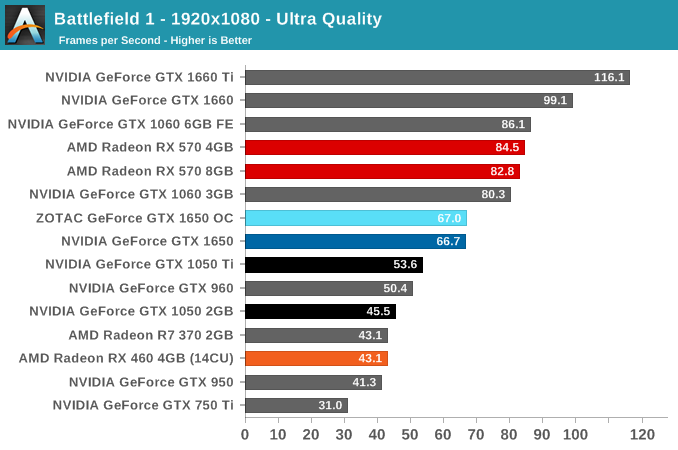
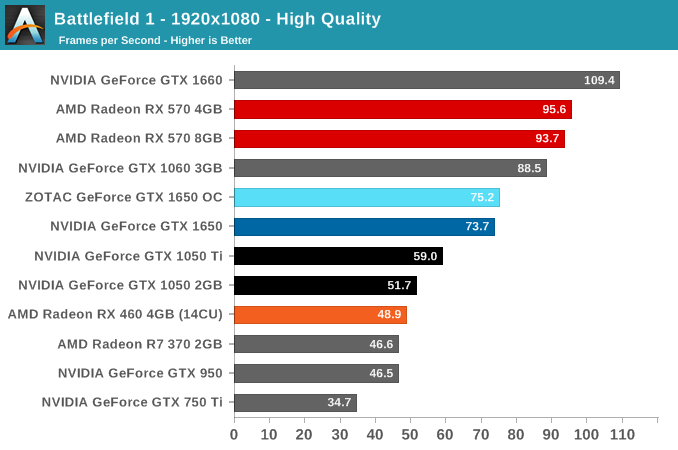
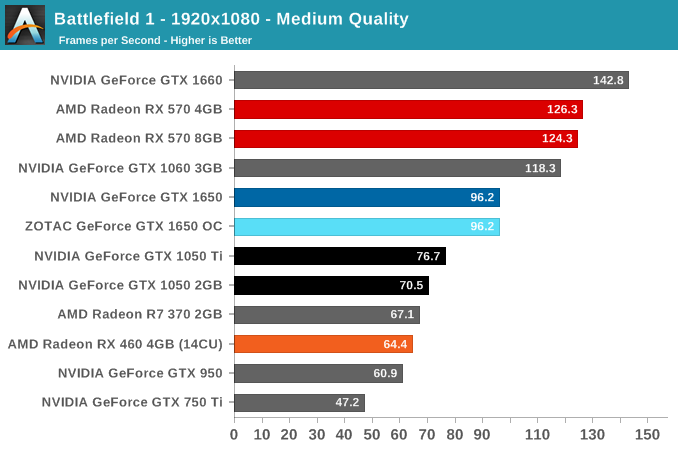
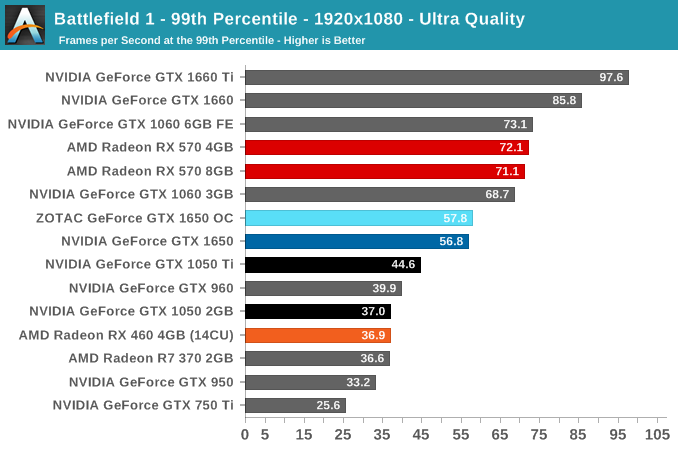
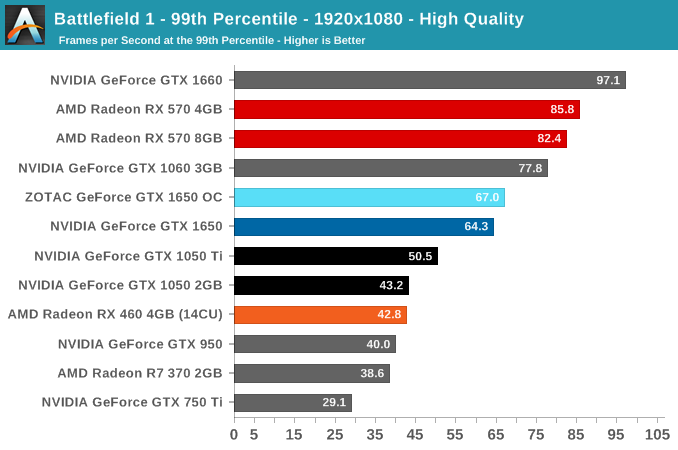
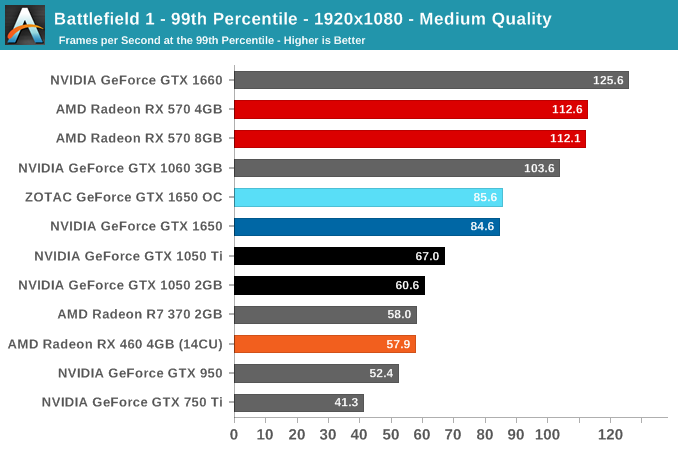
Without a direct competitor in the current generation, the GTX 1650's intended position is somewhat vague, outside of iterating on Pascal's GTX 1050 variants. Looking back to Pascal's line-up, the GTX 1650 splits the difference between the GTX 1050 Ti and GTX 1060 3GB, and far from the GTX 1660.
Compared to the RX 570 though, the GTX 1650 is handily outpaced, and Battlefield 1 where the GTX 1650 is the furthest behind. That being said, the RX 570 wasn't originally in this segment, with price being the common denominator. The RX 460, meanwhile, is well-outclassed, and the additional 2 CUs in the RX 560 would be unlikely to significantly narrow the gap.
As for the ZOTAC card, the 30 MHz is an unnoticable difference in real world terms.
Far Cry 5 (DX11)
The latest title in Ubisoft's Far Cry series lands us right into the unwelcoming arms of an armed militant cult in Montana, one of the many middles-of-nowhere in the United States. With a charismatic and enigmatic adversary, gorgeous landscapes of the northwestern American flavor, and lots of violence, it is classic Far Cry fare. Graphically intensive in an open-world environment, the game mixes in action and exploration.
The Ultra, High, and Normal presets were used. Far Cry 5 does support Vega-centric features with Rapid Packed Math and Shader Intrinsics, these were left off for testing. Far Cry 5 also supports HDR (HDR10, scRGB, and FreeSync 2). This testing was done without HD Textures enabled, an option that was recently patched in.
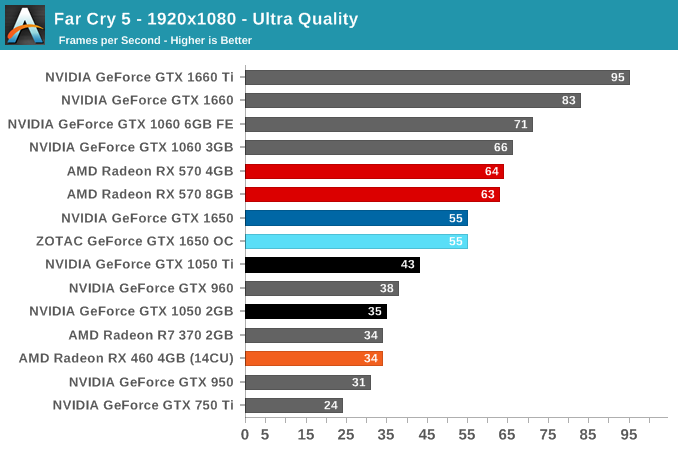
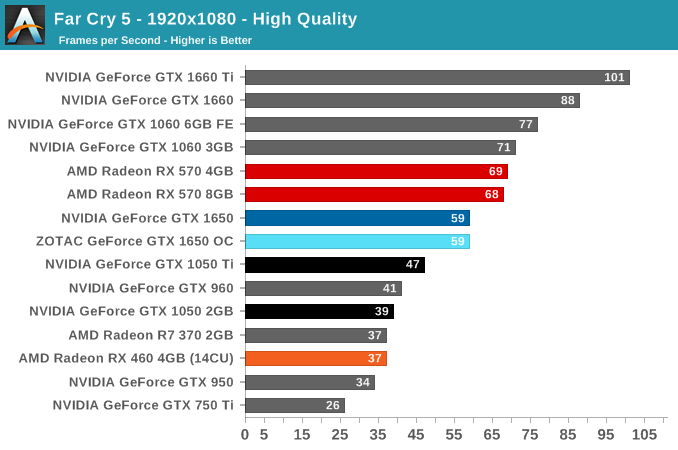
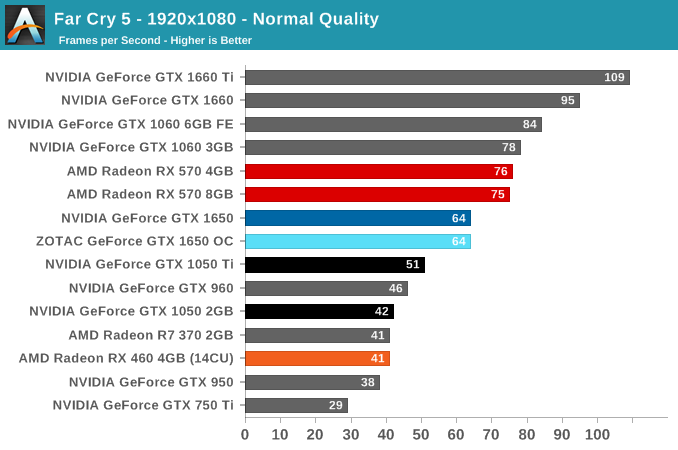
For Far Cry 5, the GTX 1650 is again perched in the GTX 1060 3GB and GTX 1050 Ti performance gap, pulling away further from the GTX 1050 Ti at more intensive settings. The RX 570, while slower than the GTX 1060 3GB in this title, is still firmly ahead of the GTX 1650.
Ashes of the Singularity: Escalation (DX12)
A veteran from both our 2016 and 2017 game lists, Ashes of the Singularity: Escalation remains the DirectX 12 trailblazer, with developer Oxide Games tailoring and designing the Nitrous Engine around such low-level APIs. The game makes the most of DX12's key features, from asynchronous compute to multi-threaded work submission and high batch counts. And with full Vulkan support, Ashes provides a good common ground between the forward-looking APIs of today. Its built-in benchmark tool is still one of the most versatile ways of measuring in-game workloads in terms of output data, automation, and analysis; by offering such a tool publicly and as part-and-parcel of the game, it's an example that other developers should take note of.
Settings and methodology remain identical from its usage in the 2016 GPU suite. To note, we are utilizing the vanilla Ashes Classic Extreme graphical preset, which compares to the current one with MSAA dialed down from x4 to x2, as well as adjusting Texture Rank (MipsToRemove in settings.ini). For today, we are also utilizing the vanilla High and Standard presets.
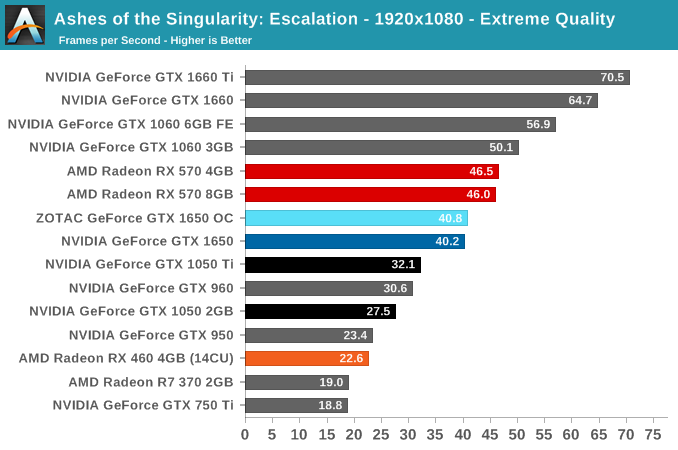
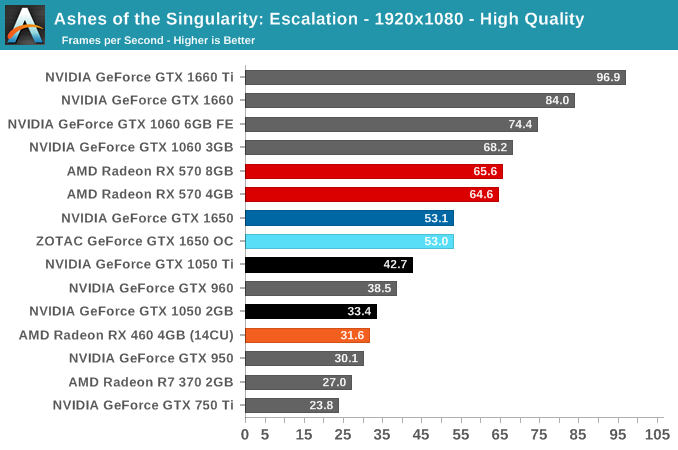
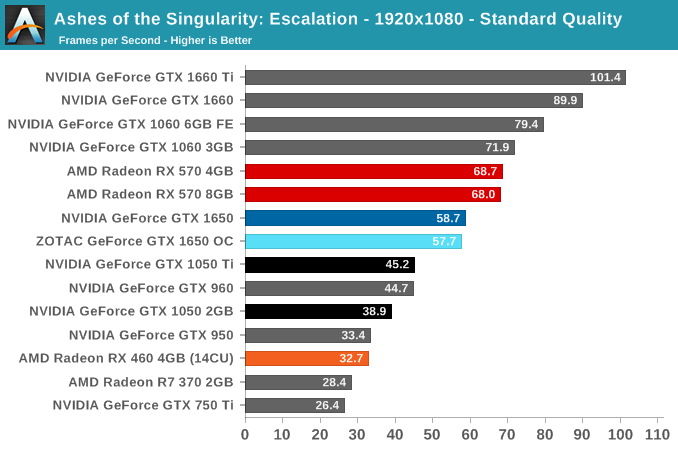
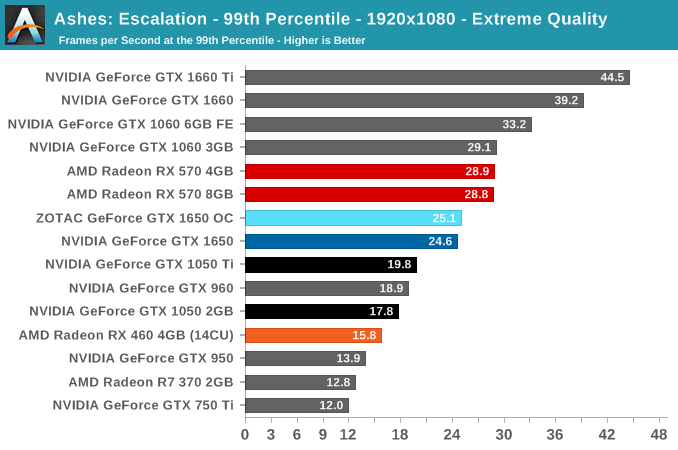
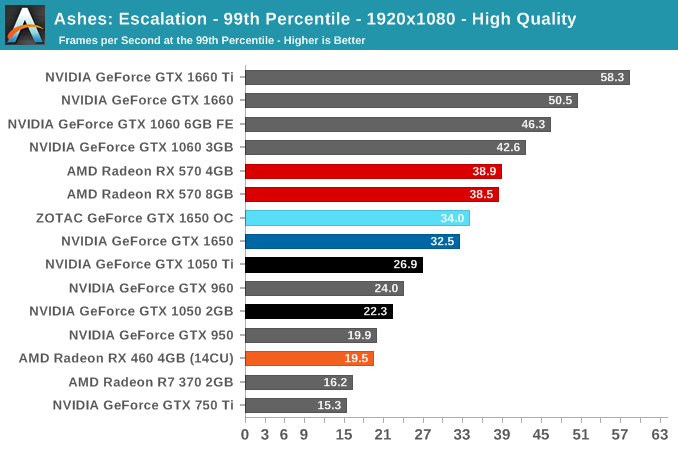
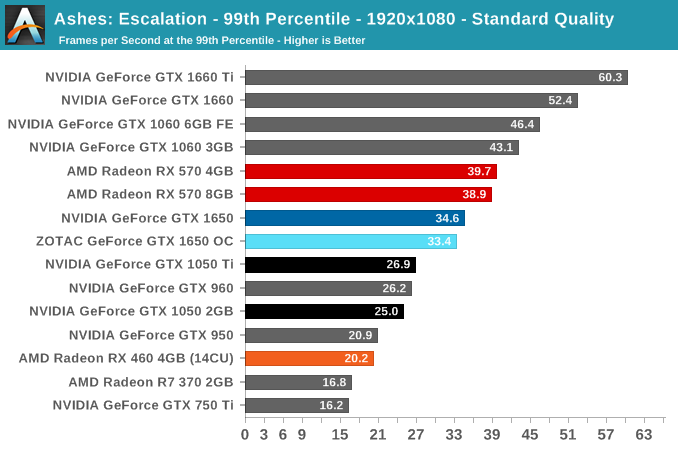
With Ashes, the GTX 1650 continues on trend, solidly slower than the RX 570 yet clearly a step up from predecessor 2GB cards.
Wolfenstein II: The New Colossus (Vulkan)
id Software is popularly known for a few games involving shooting stuff until it dies, just with different 'stuff' for each one: Nazis, demons, or other players while scorning the laws of physics. Wolfenstein II is the latest of the first, the sequel of a modern reboot series developed by MachineGames and built on id Tech 6. While the tone is significantly less pulpy nowadays, the game is still a frenetic FPS at heart, succeeding DOOM as a modern Vulkan flagship title and arriving as a pure Vullkan implementation rather than the originally OpenGL DOOM.
Featuring a Nazi-occupied America of 1961, Wolfenstein II is lushly designed yet not oppressively intensive on the hardware, something that goes well with its pace of action that emerge suddenly from a level design flush with alternate historical details.
The game has 5 total graphical presets: Mein leben!, Uber, Ultra, Medium, and Low. Staying consistent with previous 1080p testing, the highest quality preset, "Mein leben!", was used, in addition to Ultra and Medium. Wolfenstein II also features Vega-centric GPU Culling and Rapid Packed Math, as well as Radeon-centric Deferred Rendering; in accordance with the presets, neither GPU Culling nor Deferred Rendering was enabled.
To preface, an odd performance bug afflicted the two Maxwell cards (GTX 960 and GTX 950), where Medium Image Streaming (poolsize of 768) resulted in out-of-memory sub 2-fps performance. Using the Medium preset but with any other Image Streaming setting returned to normal performance, suggesting an issue with memory allocation, and occuring on earlier drivers as well. It's not clear how much this affects sub 2-fps performance at the "Mein leben!" preset, which is already much too demanding for 2GB of framebuffer.
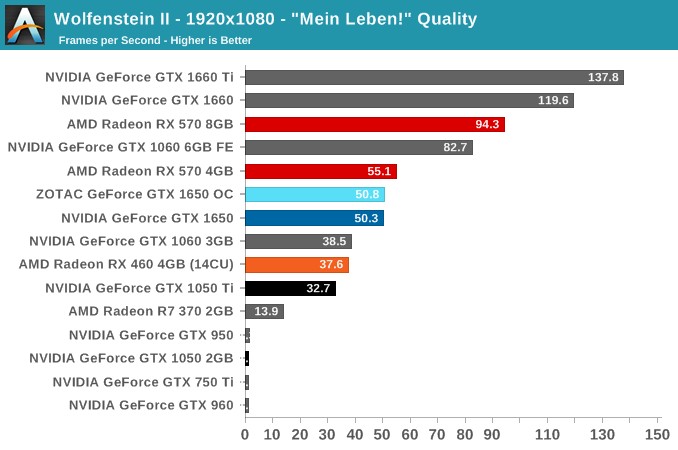
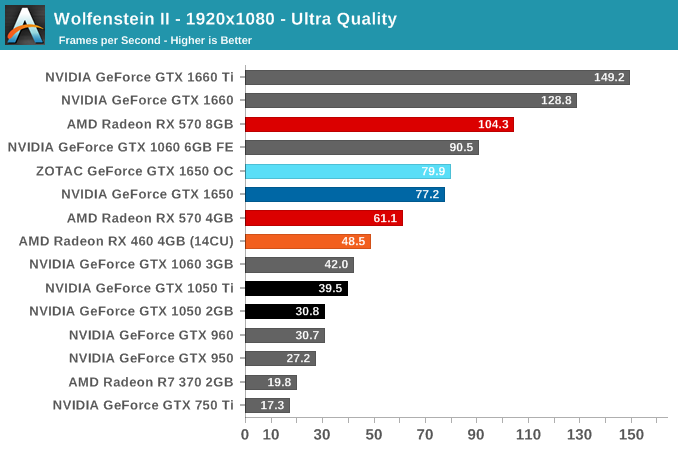
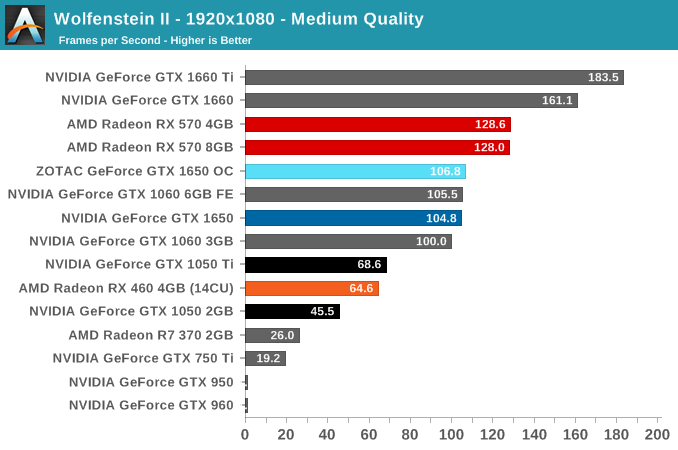
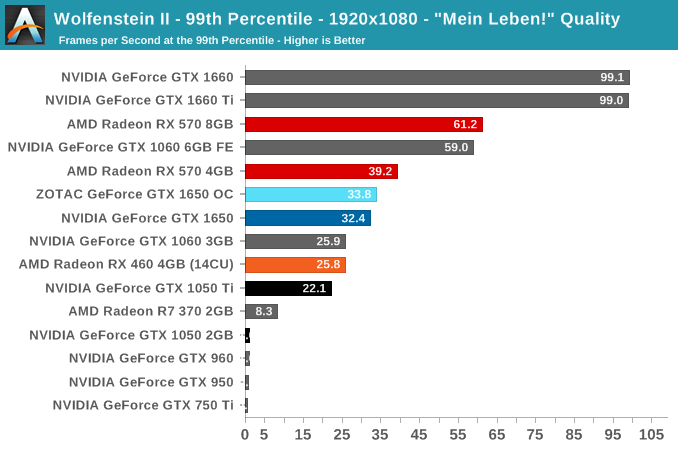
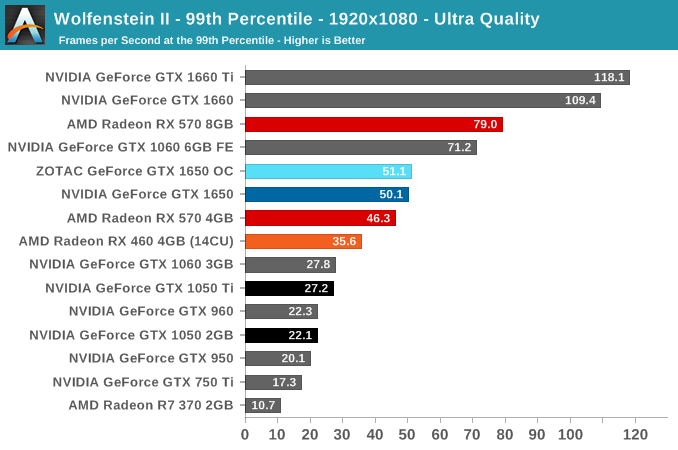

With the VRAM-hungry nature of Wolfenstein II, the GTX 1650's 4GB keeps it from suffering a premature death like all the other 2GB cards. Or even the 3GB card, in the case of the GTX 1060 3GB. Even at medium settings, the bigger framebuffer turns the tables on the GTX 1060 3GB, which is faster in every other game in the suite. So the GTX 1650 takes the lead in both performance and smoother gameplay experience.
The VRAM-centric approach does uncover more oddities; here the GTX 1650 overcomes the RX 570 4GB at higher settings, but the RX 570 8GB remains undeterred.
Final Fantasy XV (DX11)
Upon arriving to PC earlier this, Final Fantasy XV: Windows Edition was given a graphical overhaul as it was ported over from console, fruits of their successful partnership with NVIDIA, with hardly any hint of the troubles during Final Fantasy XV's original production and development.
In preparation for the launch, Square Enix opted to release a standalone benchmark that they have since updated. Using the Final Fantasy XV standalone benchmark gives us a lengthy standardized sequence to utilize OCAT. Upon release, the standalone benchmark received criticism for performance issues and general bugginess, as well as confusing graphical presets and performance measurement by 'score'. In its original iteration, the graphical settings could not be adjusted, leaving the user to the presets that were tied to resolution and hidden settings such as GameWorks features.
Since then, Square Enix has patched the benchmark with custom graphics settings and bugfixes to be more accurate in profiling in-game performance and graphical options, though leaving the 'score' measurement. For our testing, we enable or adjust settings to the 'Highest', 'High', or 'Medium' options except for NVIDIA-specific features and 'Model LOD', the latter of which is left at standard. For High, we also turn off the hi-res assets, while for Medium we also turn off 'Geomapping' (terrain tessellation). Final Fantasy XV also supports HDR, and it will support DLSS at some later date.
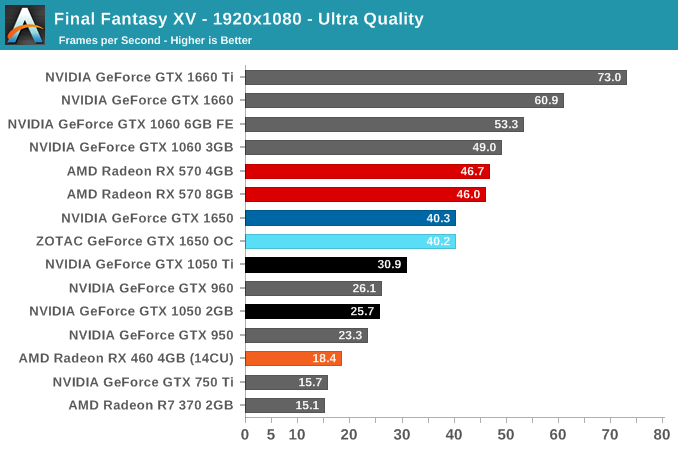
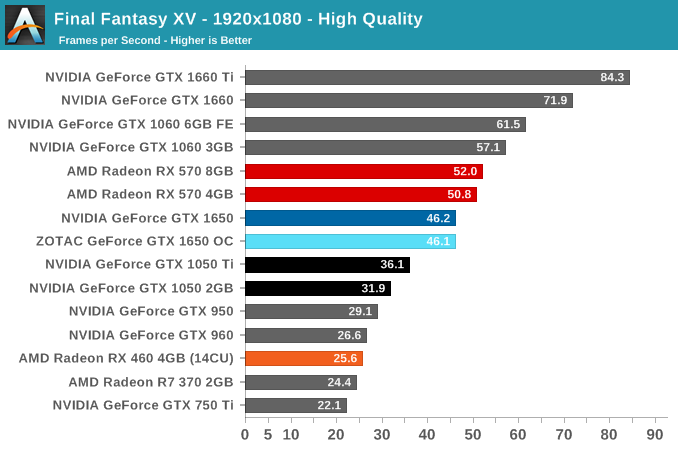
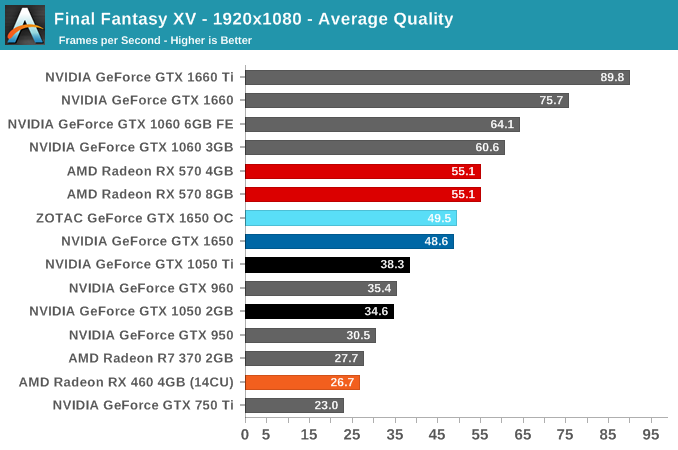
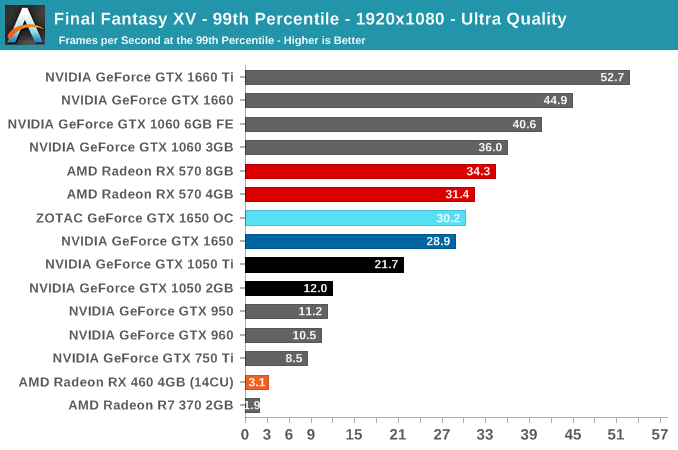
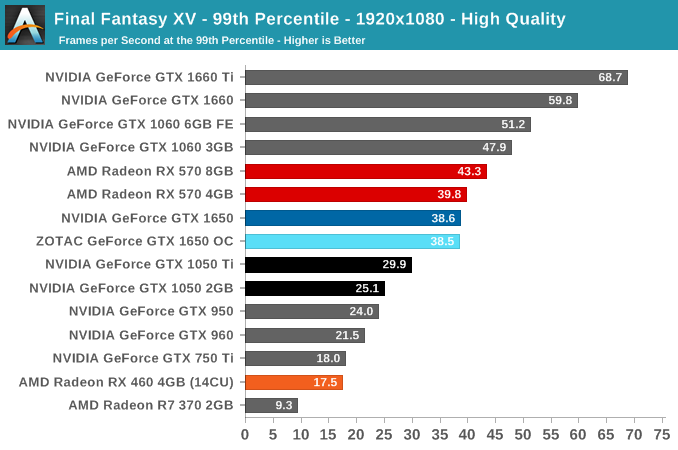
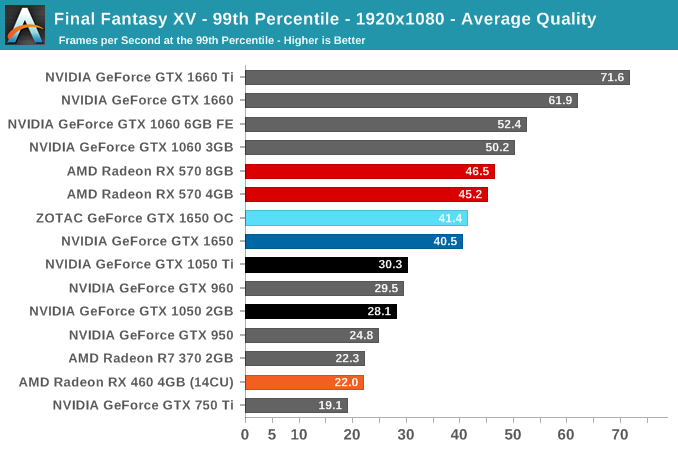
Final Fantasy V is another title that tends to prefer more VRAM, and with ultra settings and high-res textures, all the 2GB cards drop off in their 99th percentiles, reflecting the stuttering experience. The GTX 1650 is almost on par with RX 570 here at the higher settings.
Grand Theft Auto V (DX11)
Now a truly venerable title, GTA V is a veteran of past game suites that is still graphically demanding as they come. As an older DX11 title, it provides a glimpse into the graphically intensive games of yesteryear that don't incorporate the latest features. Originally released for consoles in 2013, the PC port came with a slew of graphical enhancements and options. Just as importantly, GTA V includes a rather intensive and informative built-in benchmark, somewhat uncommon in open-world games.
The settings are identical to its previous appearances, which are custom as GTA V does not have presets. To recap, a "Very High" quality is re-used to stay consistent with previous testing. For "Very High," all primary graphics settings turned up to their highest setting, except grass, which is at its own very high setting. Meanwhile 4x MSAA is enabled for direct views and reflections. This setting also involves turning on some of the advanced rendering features - the game's long shadows, high resolution shadows, and high definition flight streaming - but not increasing the view distance any further.
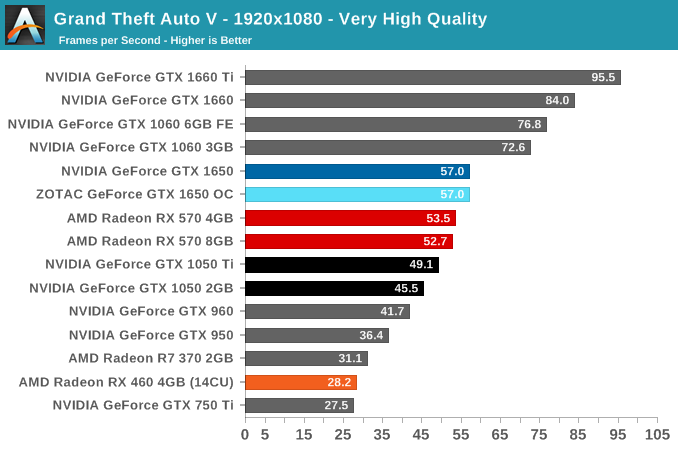
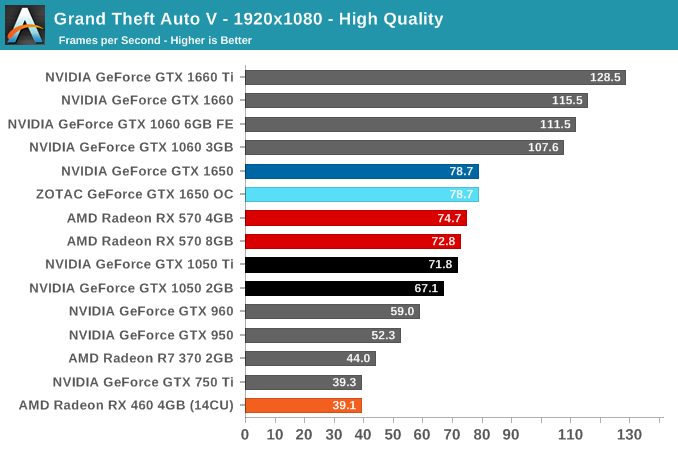
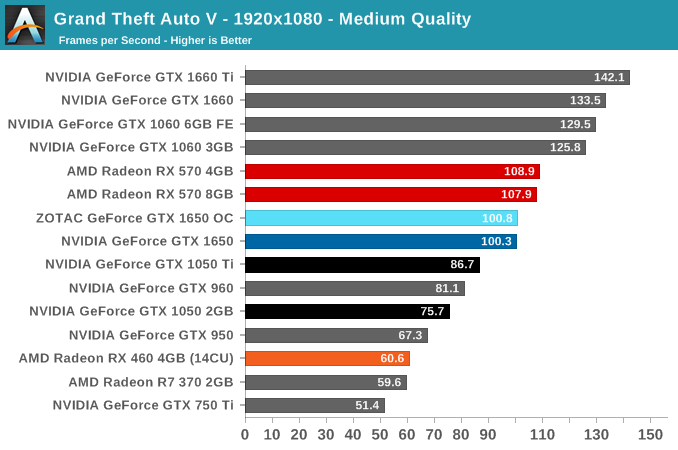
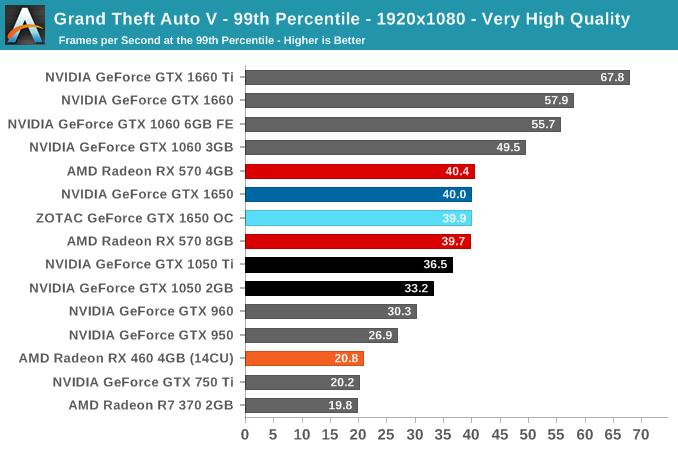
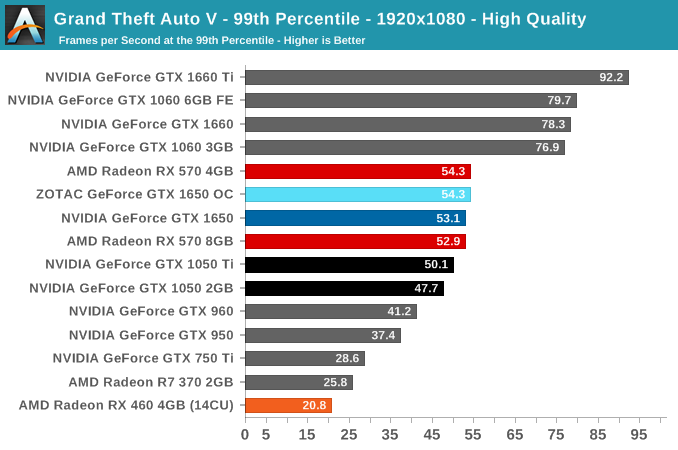
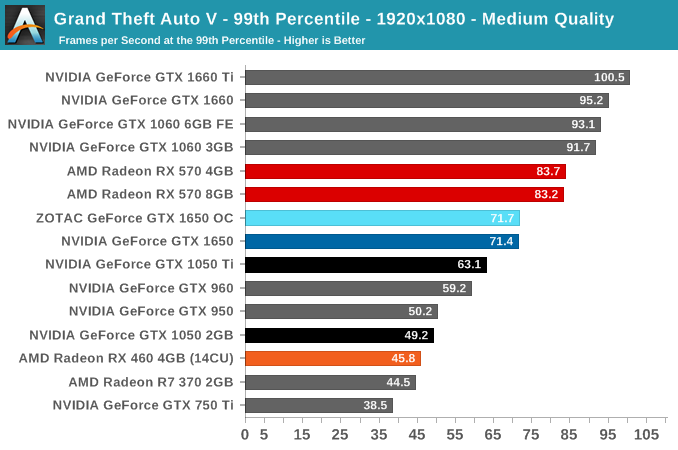
Overall, while NVIDIA hardware tends to perform well on GTA, the GTX 1650 has the smallest lead on the GTX 1050 cards compared to the other titles in the suite. Although firmly edging out those cards, it opens a sizable performance gap to the GTX 1060 3GB. Its relative performance compared to the Pascal predecessors is in line with the GTX 1660 and 1660's modest lead on the GTX 1060 6GB and 3GB.
Middle-earth: Shadow of War (DX11)
Next up is Middle-earth: Shadow of War, the sequel to Shadow of Mordor. Developed by Monolith, whose last hit was arguably F.E.A.R., Shadow of Mordor returned them to the spotlight with an innovative NPC rival generation and interaction system called the Nemesis System, along with a storyline based on J.R.R. Tolkien's legendarium, and making it work on a highly modified engine that originally powered F.E.A.R. in 2005.
Using the new LithTech Firebird engine, Shadow of War improves on the detail and complexity, and with free add-on high resolution texture packs, offers itself as a good example of getting the most graphics out of an engine that may not be bleeding edge. The built-in Ultra, High, and Medium presets were used without modifications. Shadow of War also supports HDR (HDR10).
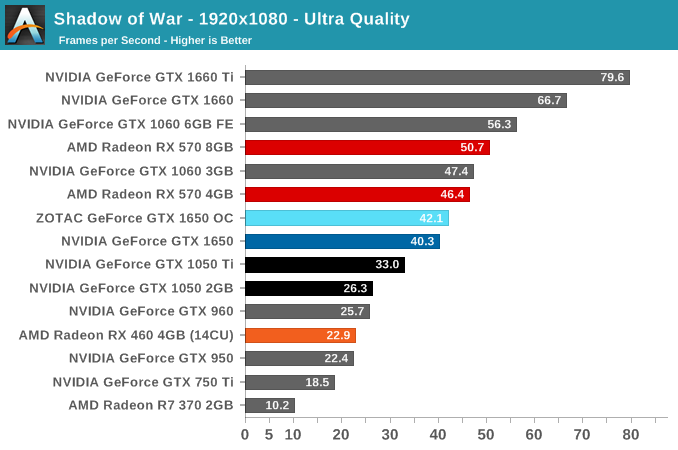
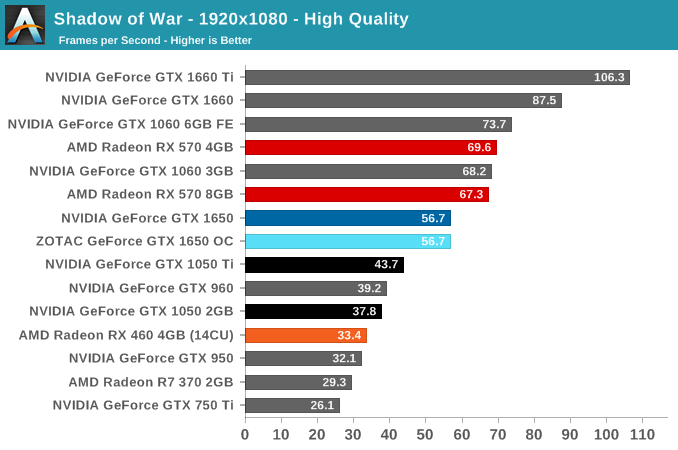
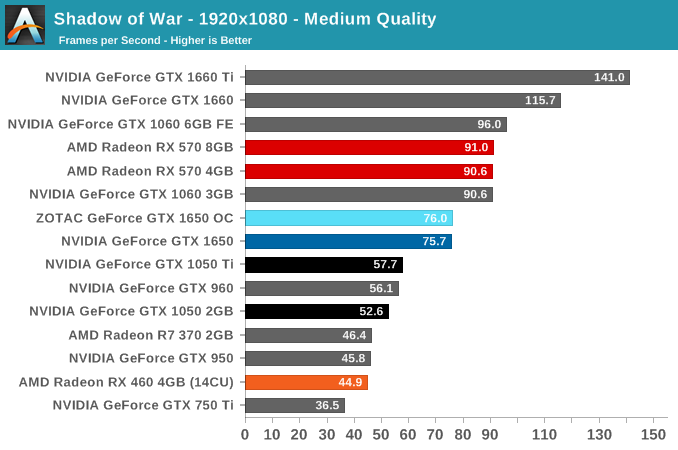
The GTX 1650 returns to its spot in between the GTX 1050 Ti and GTX 1060 3GB, and given Shadow of War's video memory preferences, with 4GB of VRAM the card avoids any potential issues with inadequate framebuffer.
F1 2018 (DX11)
Succeeding F1 2016 is F1 2018, Codemaster's latest iteration in their official Formula One racing games. It features a slimmed down version of Codemasters' traditional built-in benchmarking tools and scripts, something that is surprisingly absent in DiRT 4.
Aside from keeping up-to-date on the Formula One world, F1 2017 added HDR support, which F1 2018 has maintained; otherwise, we should see any newer versions of Codemasters' EGO engine find its way into F1. Graphically demanding in its own right, F1 2018 keeps a useful racing-type graphics workload in our benchmarks.
The Ultra High, High, and Medium quality presets were used without modification.
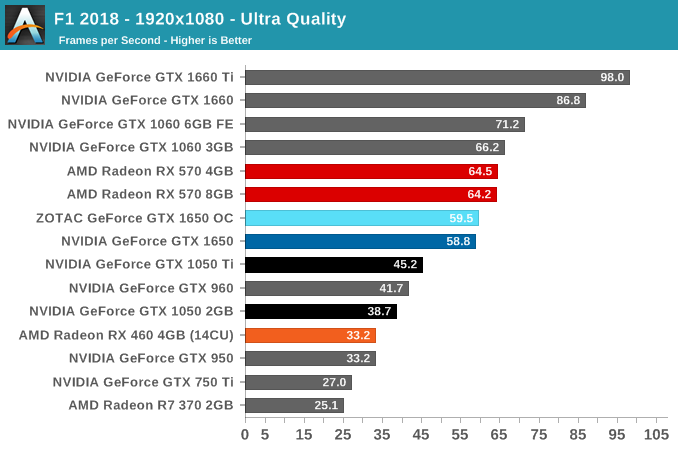
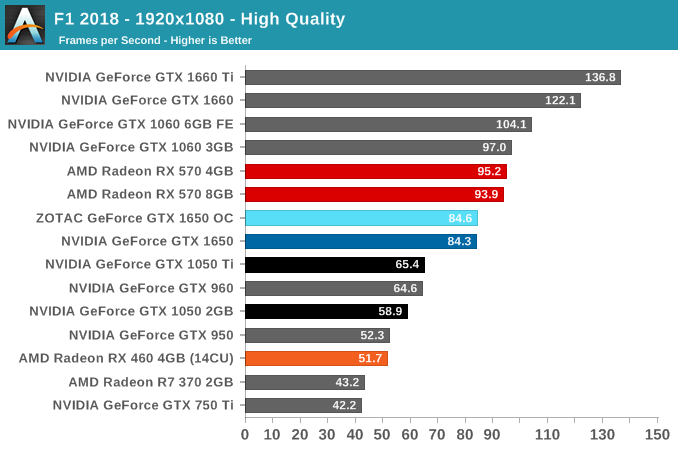
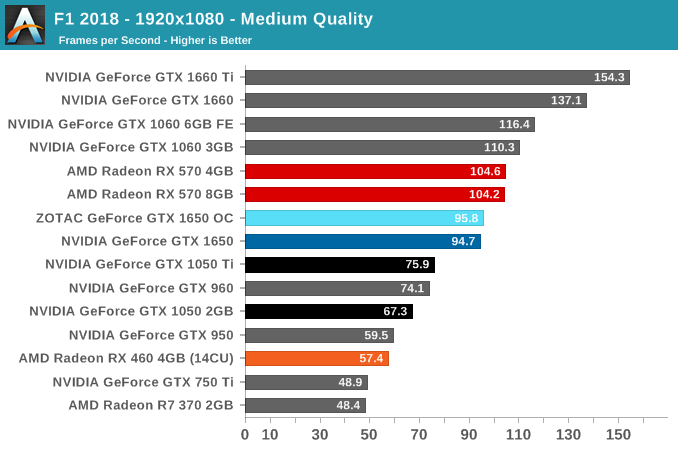
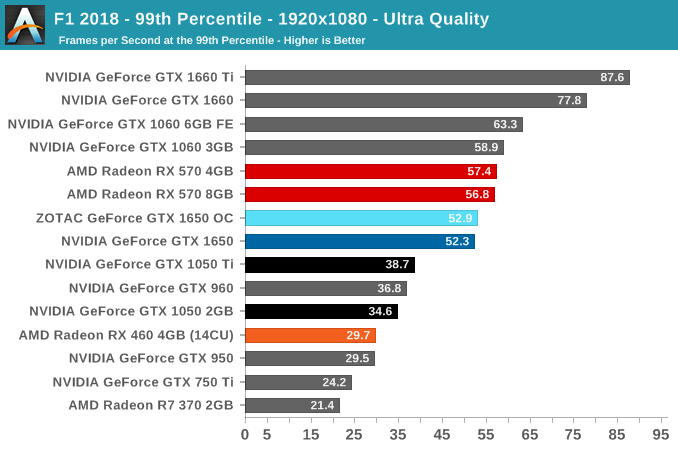
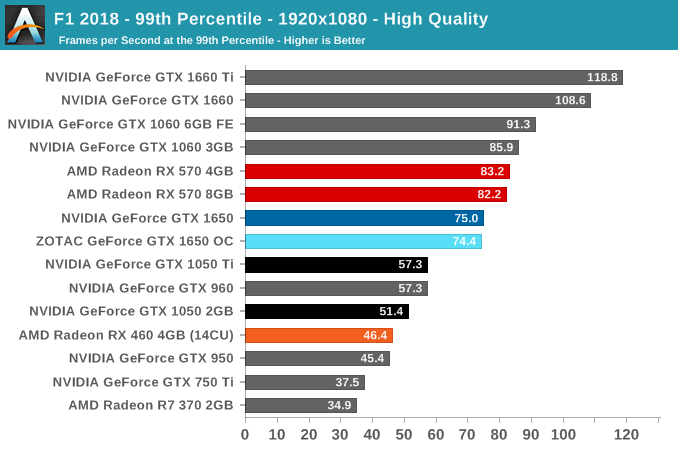
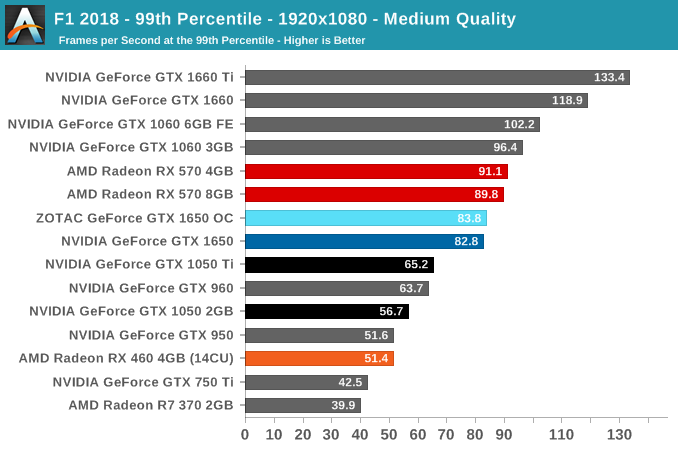
F1 is another strong showing for the GTX 1650, offering performance closer to the GTX 1060 3GB than the GTX 1050 Ti, and coming within range of the RX 570.
Total War: Warhammer II (DX11)
Last in our 2018 game suite is Total War: Warhammer II, built on the same engine of Total War: Warhammer. While there is a more recent Total War title, Total War Saga: Thrones of Britannia, that game was built on the 32-bit version of the engine. The first TW: Warhammer was a DX11 game was to some extent developed with DX12 in mind, with preview builds showcasing DX12 performance. In Warhammer II, the matter, however, appears to have been dropped, with DX12 mode still marked as beta, but also featuring performance regression for both vendors.
It's unfortunate because Creative Assembly themselves have acknowledged the CPU-bound nature of their games, and with re-use of game engines as spin-offs, DX12 optimization would have continued to provide benefits, especially if the future of graphics in RTS-type games will lean towards low-level APIs.
The standard Ultra, High, and Medium presets were used with the more graphically-bound battle benchmark.
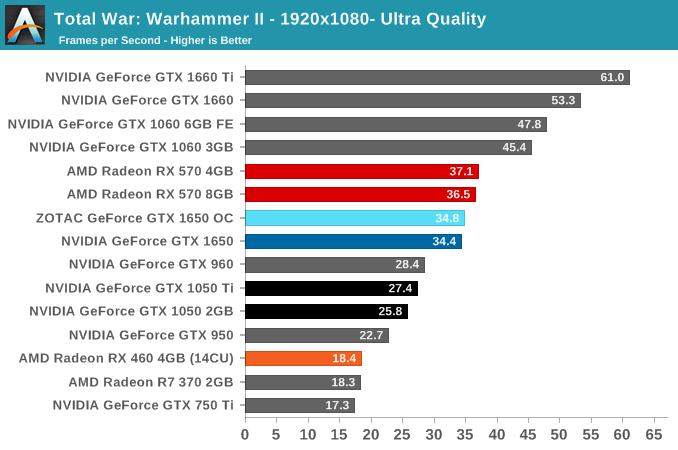
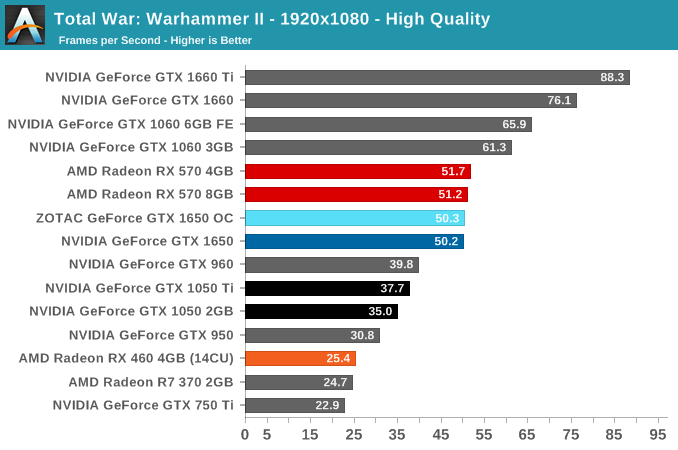
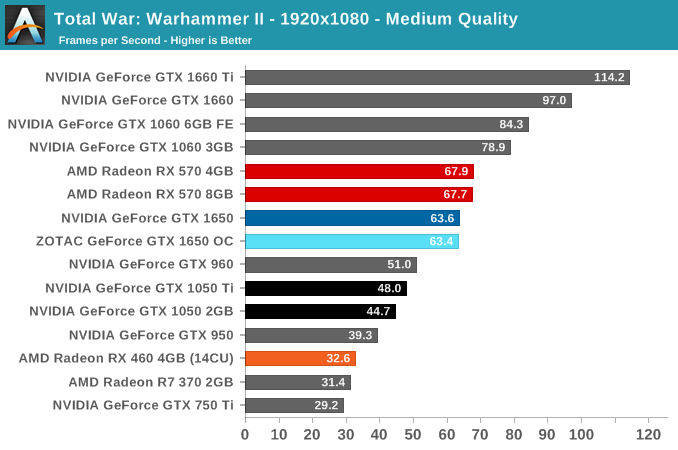
Rounding out our look at game performance is Total War: Warhammer II. While the GTX 1650 is closer to the GTX 1050 Ti than the GTX 1060 3GB, the subdued performance of the RX 570 brings them near-level.
Compute & Synthetics
Shifting gears, we'll look at the compute and synthetic aspects of the GTX 1650. As we've seen the GTX 1660 Ti and GTX 1660 already, we aren't expecting anything too surprising here.
Beginning with CompuBench 2.0, the latest iteration of Kishonti's GPU compute benchmark suite offers a wide array of different practical compute workloads, and we’ve decided to focus on level set segmentation, optical flow modeling, and N-Body physics simulations.
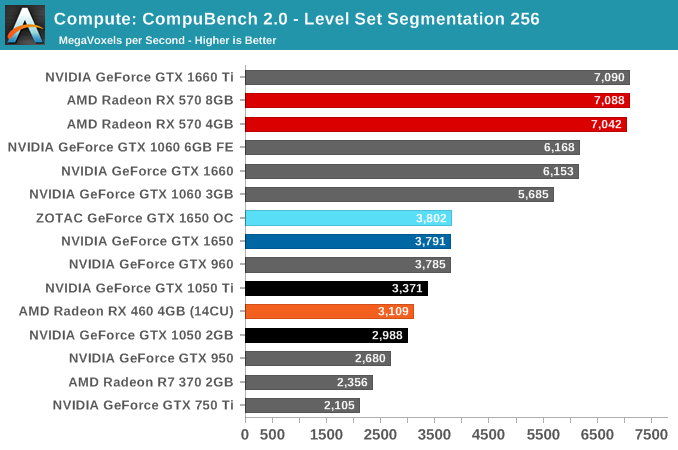
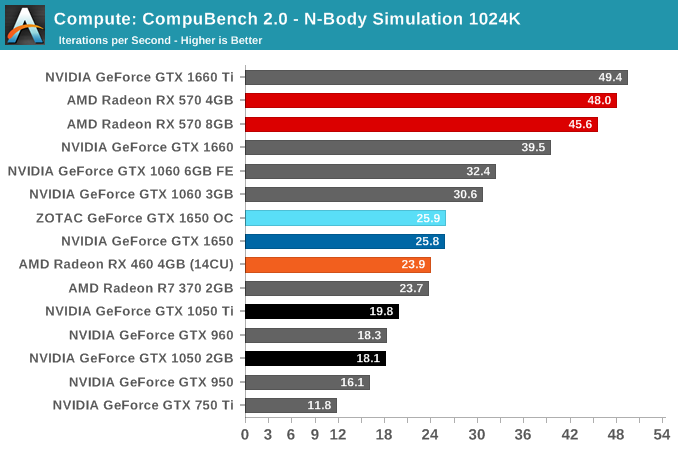
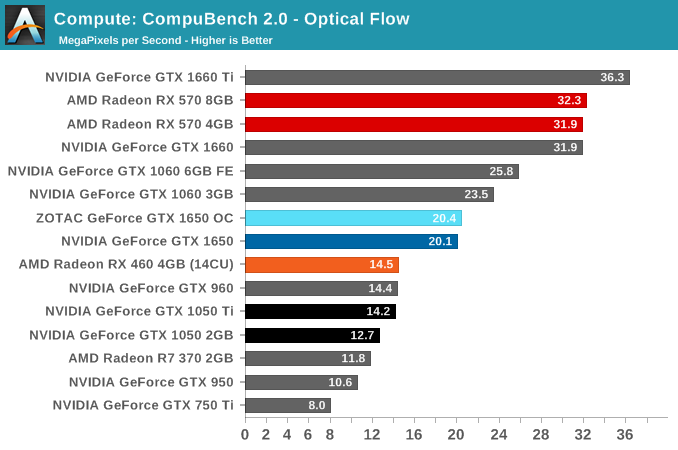
Moving on, we'll also look at single precision floating point performance with FAHBench, the official Folding @ Home benchmark. Folding @ Home is the popular Stanford-backed research and distributed computing initiative that has work distributed to millions of volunteer computers over the internet, each of which is responsible for a tiny slice of a protein folding simulation. FAHBench can test both single precision and double precision floating point performance, with single precision being the most useful metric for most consumer cards due to their low double precision performance.
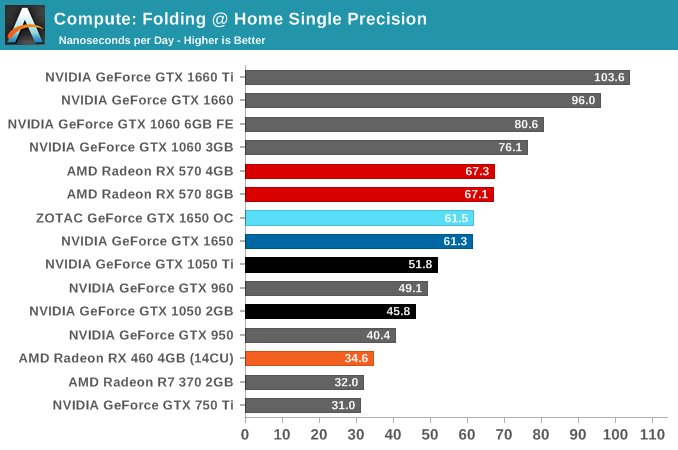
Next is Geekbench 4's GPU compute suite. A multi-faceted test suite, Geekbench 4 runs seven different GPU sub-tests, ranging from face detection to FFTs, and then averages out their scores via their geometric mean. As a result Geekbench 4 isn't testing any one workload, but rather is an average of many different basic workloads.
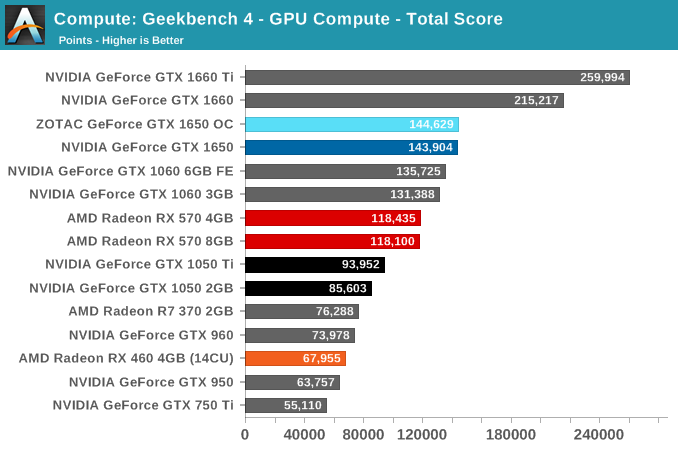
In lieu of Blender, which has yet to officially release a stable version with CUDA 10 support, we have the LuxRender-based LuxMark (OpenCL) and V-Ray (OpenCL and CUDA).
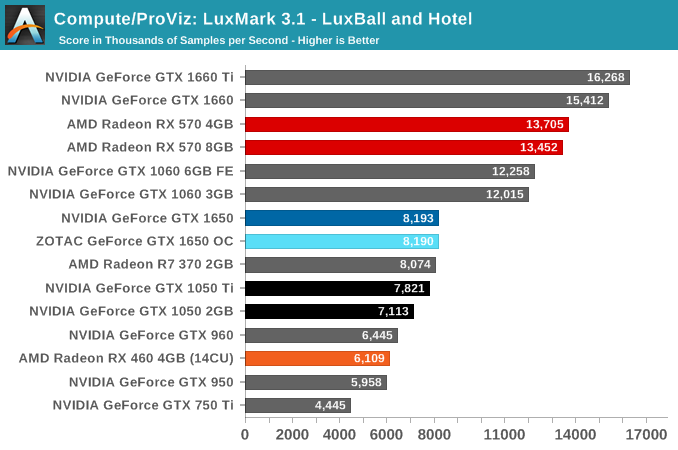
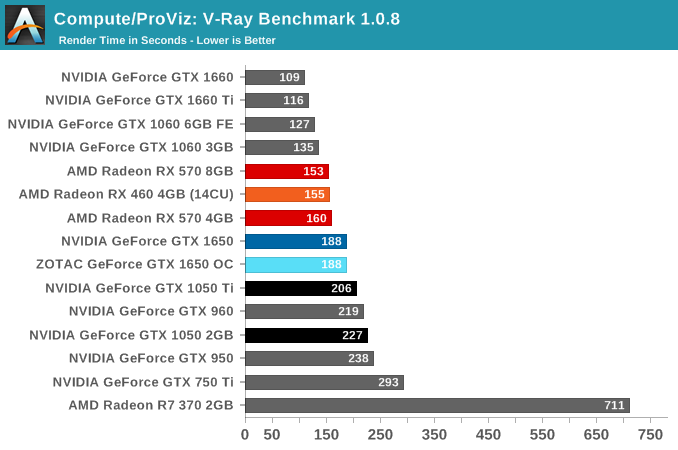
We'll also take a quick look at tessellation performance.
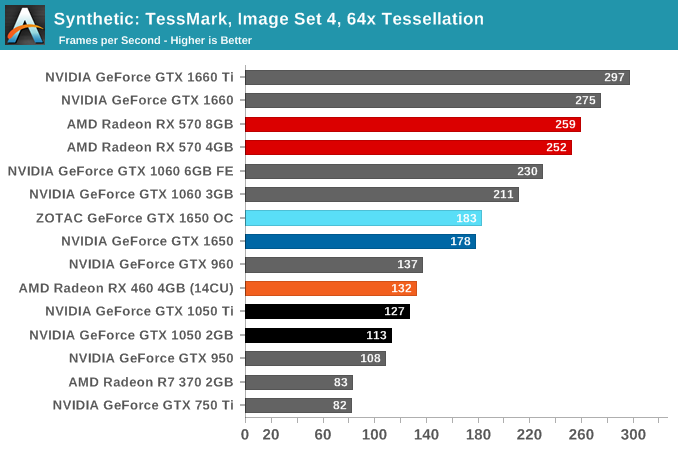
Finally, for looking at texel and pixel fillrate, we have the Beyond3D Test Suite. This test offers a slew of additional tests – many of which we use behind the scenes or in our earlier architectural analysis – but for now we’ll stick to simple pixel and texel fillrates.
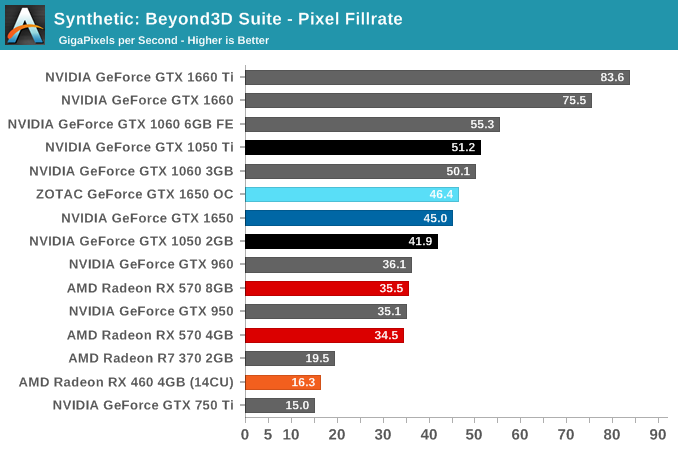
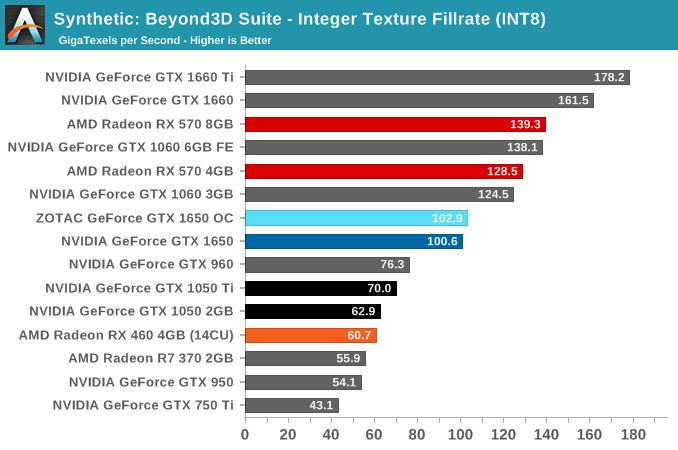
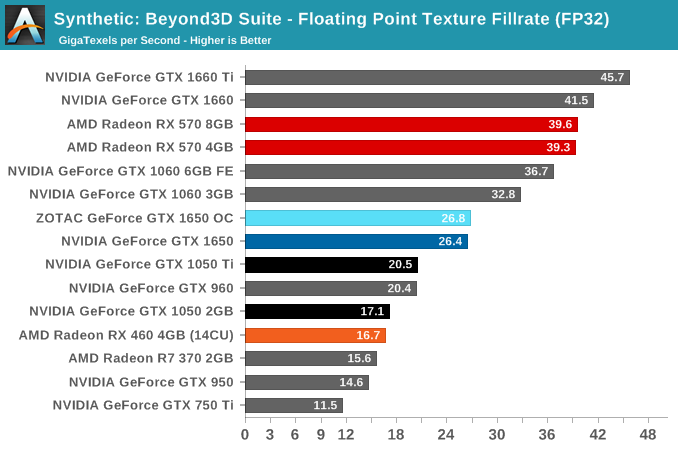
Power, Temperature, and Noise
As always, we'll take a look at power, temperature, and noise of the GTX 1650, though the 'mini' design shouldn't hold any surprises.
| GeForce Video Card Average Clockspeeds | |||||
| Game | GTX 1650 | ZOTAC GTX 1650 OC Gaming |
|||
| Boost Clock | 1665MHz | 1695MHz | |||
| Battlefield 1 | 1855MHz | 1880MHz | |||
| Far Cry 5 | 1847MHz | 1886MHz | |||
| Ashes: Escalation | 1826MHz | 1829MHz | |||
| Wolfenstein II | 1860MHz | 1905MHz | |||
| Final Fantasy XV | 1867MHz | 1837MHz | |||
| GTA V | 1886MHz | 1905MHz | |||
| Shadow of War | 1857MHz | 1863MHz | |||
| F1 2018 | 1855MHz | 1875MHz | |||
| Total War: Warhammer II | 1865MHz | 1902MHz | |||
| FurMark | 1629MHz | 1672MHz | |||
Power Consumption
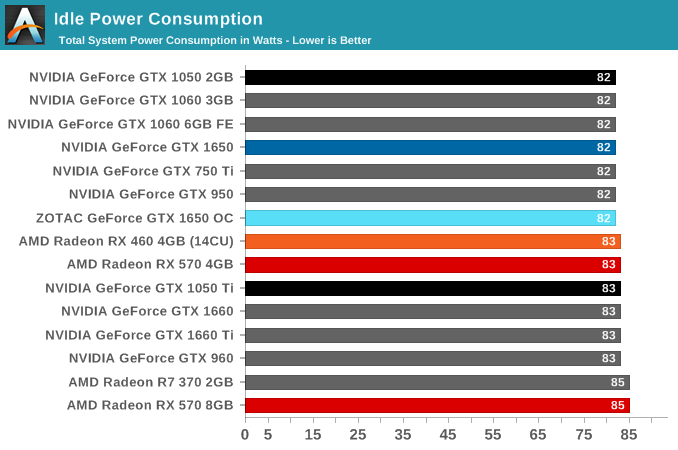
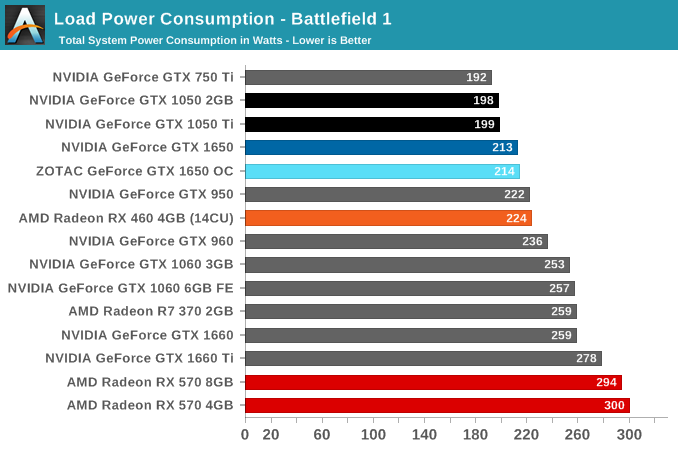
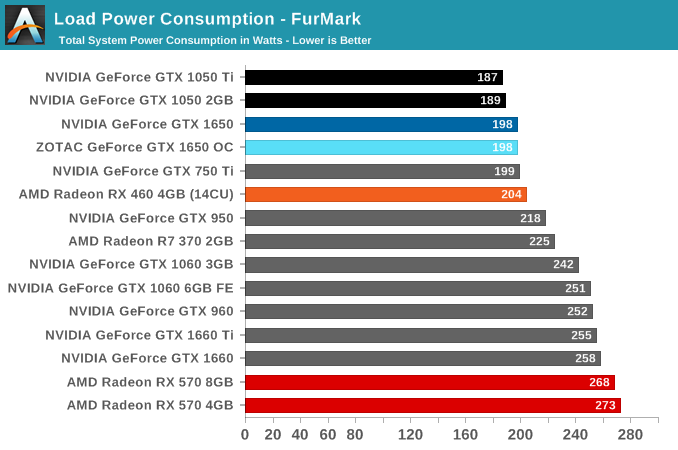
As for idle power consumption, the GTX 1650 falls in line with everything else, with total system power consumption reaching 83W. With contemporary desktop cards, idle power has reached the point where nothing short of low-level testing can expose what these cards are drawing.
Meanwhile at full load, the power consumption disparity between the RX 570 and GTX 1650 is one of the key factors in a direct comparison. Better – but not always – performance can be had for an additional ~75W at the wall, which maps well to the 150W TBP of the RX 570 over the 75W slot-power-only GTX 1650. Though the greater cooling requirements for a higher power card does means forgoing the small form factor.
Temperature
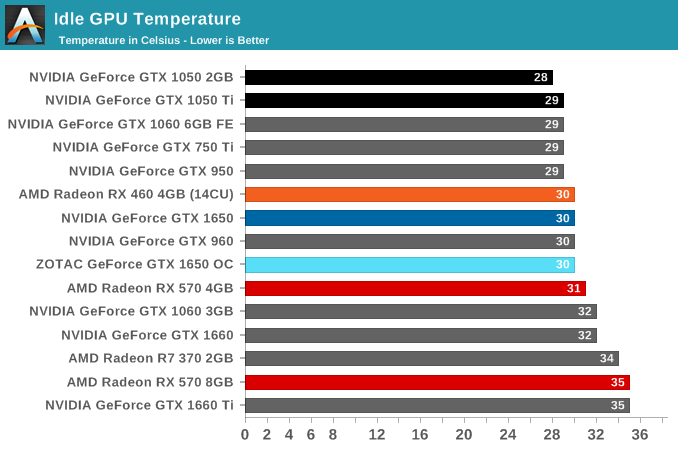
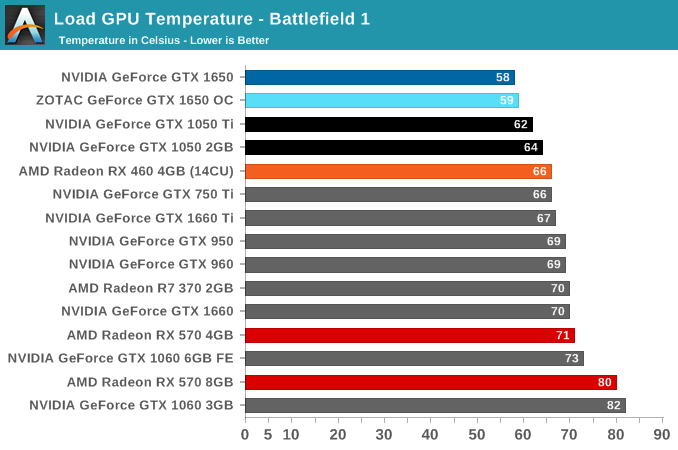
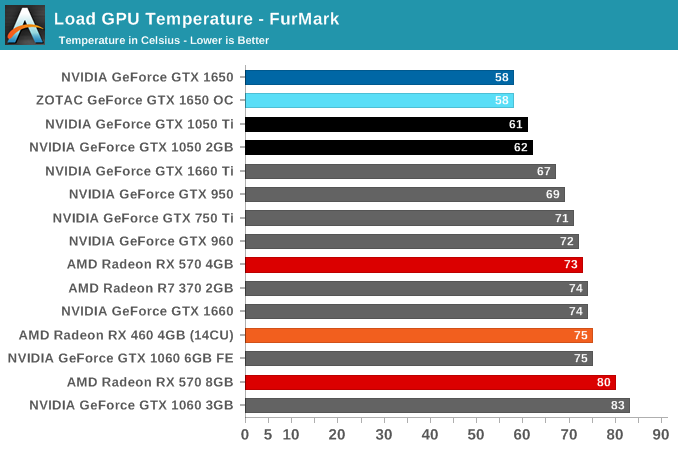
Temperatures all appear fairly normal, as the GTX 1650 stays very cool under load.
Noise
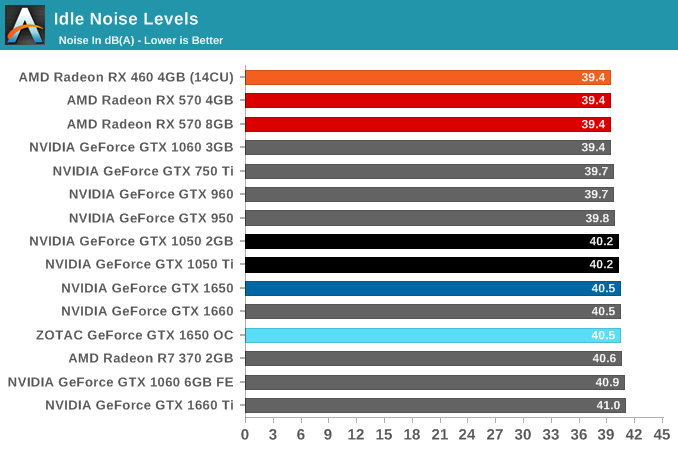
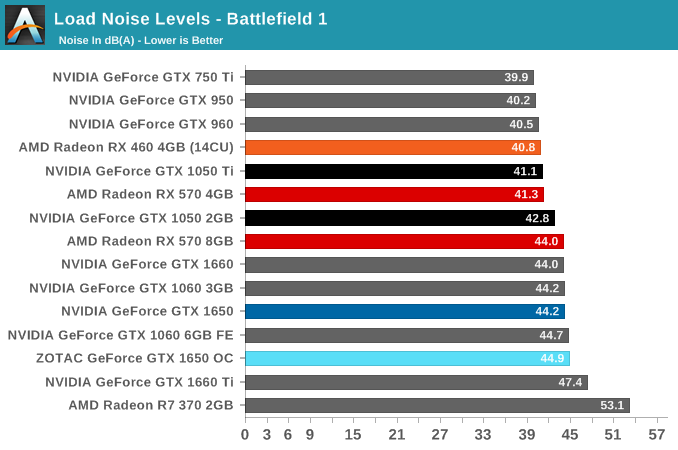
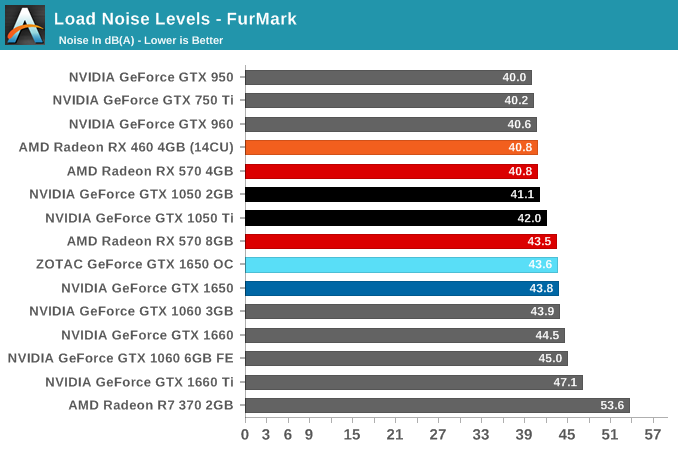
While the GTX 1650 may have good power and temperature characteristics, the noise is not as clean, if only because entry-level cards don't come with 0db fan idling technology, and SFF cards often have to deal with small shrill fans at relatively high RPM. The GTX 1650's fan isn't the worst, but it's not a standout best either. If anything, it looks to be the result of preferring cooling over acoustics, given the very low load temperatures.
Closing Thoughts
Wrapping up our look at what would seem to be the last GeForce desktop video card launch for the time being, the GeForce GTX 1650 caps off the Turing launch cycle in an interesting manner. On the one hand, NVIDIA’s pure technological dominance has never been quite so prominent as it is with the GTX 1650. On the other hand, their outright value of their lead over rival AMD has never been quite so muddled. As I noted earlier in this review, the GTX 1650 is a card that serves many masters, and it serves some better than others.
Overall, NVIDIA is treading in very familiar territory here, thanks to their well-defined product stack. The GTX 1650 is a low-end video card. It’s a low-priced video card. It’s a low-power video card. It’s a video card that no doubt will be filling OEM gaming systems left and right as the stock video card – and it’ll be a card that fills countless older OEM systems that need a pick-me-up that runs under 75W. It fills all of these roles well – as a GTX xx50 card should – but it’s also a card that definitely faces stiffer competition than the other members of the Turing GeForce family.
From a tech perspective then, GTX 1650 and its underlying TU117 GPU are another example of consistent execution on Turing GPU development by NVIDIA. By this point the Turing architecture is a known quantity – faster, more efficient, and packing a number of new graphics features – so for our regular readers who have been with us since the RTX 2080 launch, the GTX 1650 doesn’t get the luxury of delivering any big surprises here. But then “big” is the very opposite of what NVIDIA aimed to do with the GTX 1650; instead this launch is all about bringing the Turing architecture and its benefits down to their smallest GPU and video cards.
By the numbers then, the GeForce GTX 1650’s story is very similar to this year’s other GeForce launches. The $149 card is about 30% faster than its most comparable predecessor, the GTX 1050 Ti, which is just a bit under the generational performance gains we’ve seen from the other Turing cards. Like those other cards the performance gains aren’t nearly large enough to justify replacing an existing GeForce 10 series Pascal card, but it’s a far more enticing upgrade for replacing the GTX 750, GTX 950, and similar cards that are now a couple of generations old. Against the GTX 950 the new GTX 1650 is 63% faster, and compared to the GTX 750 Ti that’s a 111% performance lead.
| GeForce: Turing versus Pascal | ||||||
| List Price (Turing) |
Relative Performance | Relative Price |
Relative Perf-Per-Dollar |
|||
| RTX 2080 Ti vs GTX 1080 Ti | $999 | +32% | +42% | -7% | ||
| RTX 2080 vs GTX 1080 | $699 | +35% | +40% | -4% | ||
| RTX 2070 vs GTX 1070 | $499 | +35% | +32% | +2% | ||
| RTX 2060 vs GTX 1060 6GB | $349 | +59% | +40% | +14% | ||
| GTX 1660 Ti vs GTX 1060 6GB | $279 | +36% | +12% | +21% | ||
| GTX 1660 vs GTX 1060 3GB | $219 | +28% | +10% | +16% | ||
| GTX 1650 vs GTX 1050 Ti | $149 | +30% | +7% | +21% | ||
These performance gains also mean that the GTX 1650 is assuming the mantle as the best sub-75W video card on the market. The 30% performance gain over the previous holder, the GTX 1050 Ti, comes with only the slightest increase in power consumption – and easily staying under the 75W cap – making it the card to get for TDP-constrained systems. And HTPC users will find that it can decode every format thrown at it, from VP9 Profile 2 to all sorts of permutations of HEVC, making it a great candidate for driving the latest generation of HDR TVs. Just don't make plans to do HEVC encoding with the card if you care about bitrate efficiency.
All told, NVIDIA has ruled the roost for a while now in the 75W space, and the GTX 1650 only further widens this gap. NVIDIA cotinues to hold an edge on features, all the while enjoying a staggering 70% performance advantage over AMD’s most comparable 75W Radeon RX 560 cards.
But for everything going for it from a technology perspective, the GTX 1650 does face one big hurdle: AMD’s tenacity and willingness to sell GPUs with a thinner profit margin. While the GTX 1650 handily disposes of the Radeon RX 560, the Radeon RX 570 is another matter. An outright mid-range card that has seen its price knocked down to under $150, the RX 570 brings more of everything to the table. More performance, more memory, more memory bandwidth, more bundled games, and more power consumption. AMD can’t match NVIDIA on features or architectural efficiency at this point, but they can sure undercut NVIDIA’s pricing, and that’s exactly what the company has opted to do.
The end result is that while the GTX 1650 is easily the best sub-75W card on the market, it’s a whole different game once power consumption (and power efficiency) go out the window. On a pure performance basis AMD’s petite Polaris card offers around 11% better performance than the GTX 1650, and if you’re buying a video card in this price range, then that’s more than enough of a difference to take notice. The GTX 1650 may be technologically superior here, but if all you’re after is the best performance for the price then the decision is an easy one to make, and AMD is happy to win on sheer brute force.
It’s an unusual way to cap off the GeForce Turing launch, to say the least: NVIDIA, as it turns out, is both at its most and least competitive at the very bottom of its product stack. But with that said, NVIDIA could always cut the price of the GTX 1650 to be more in line with its performance – essentially spoiling AMD’s RX 570 on price. However, given the GTX 1650’s other strengths – not to mention NVIDIA’s significant OEM and branding advantages – I seriously doubt that NVIDIA has much incentive to do that. Instead it looks like NVIDIA is content to let AMD swing the RX 570 around, at least for now. However it bears noting that the GTX 1650 is not a fully-enabled TU117 card, and while I don’t expect a theoretical GTX 1650 Ti any time soon, at some point NVIDIA is going to roll that out and rebalance the market once more.
Last but not least, let’s shift gears and talk about the specific GTX 1650 we reviewed today, Zotac’s GAMING GeForce GTX 1650 OC. Zotac’s sole GTX 1650 card, the GAMING OC is competing in a market full of GTX 1650 cards from other board partners, and yet amongst all of those cards it’s arguably one of the purest GTX 1650 cards on the market. Despite NVIDIA’s intentions for the GTX 1650, most of their board partners went and built factory overclocked cards that blow right past the GTX 1650’s reference TDP of 75W, negating several of the GTX 1650’s advantages. Zotac’s GAMING GeForce GTX 1650 OC, by comparison, is a true 75W card, putting it in rare company as one of the only GTX 1650 cards that can actually be installed in virtually any system and powered entirely by the PCIe slot.
The end result is that, even with the extremely mild factory overclock, Zotac’s GAMING OC card is a solid baseline GTX 1650 card. The compact card doesn’t require an external PCIe power plug, and as a result can be dropped in almost any system. And at 5.54” long, it’s also among the shortest GTX 1650 cards on the market, letting it easily squeeze into smaller systems, including Mini-ITX machines.
In fact the only real drawback I can come up with for the card is its noise; while by no means loud, we have seen and tested other similar double-slot/single-fan cards before that are quieter. So while it’s still a solid choice for small systems, it’s not going to be an entirely silent card in the process. But if nothing else, this leaves Zotac with some room for a fully passive GTX 1650, which, I suspect, is something that would be particularly well-received in the HTPC market.

